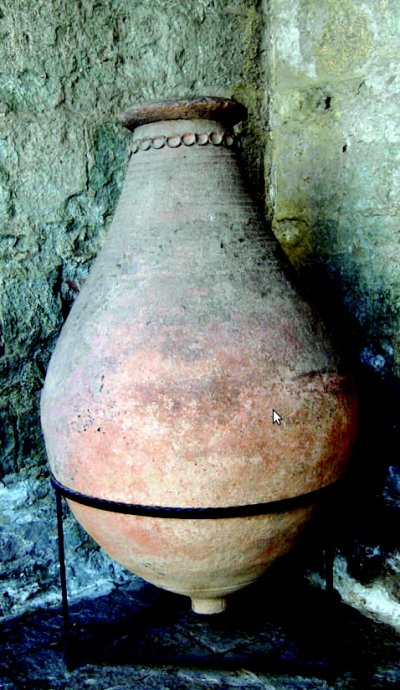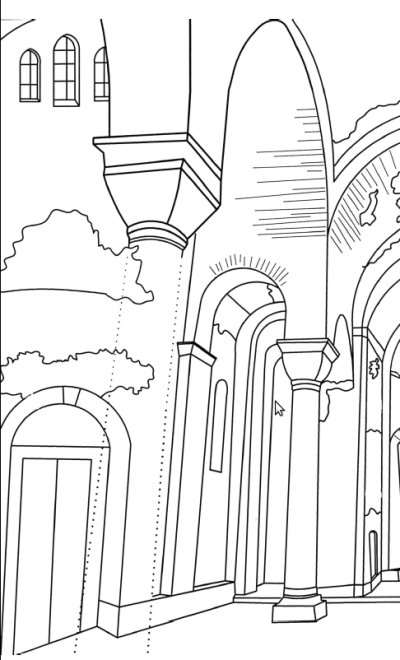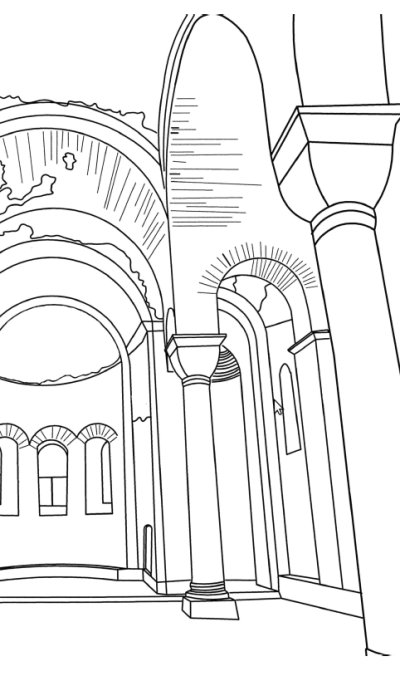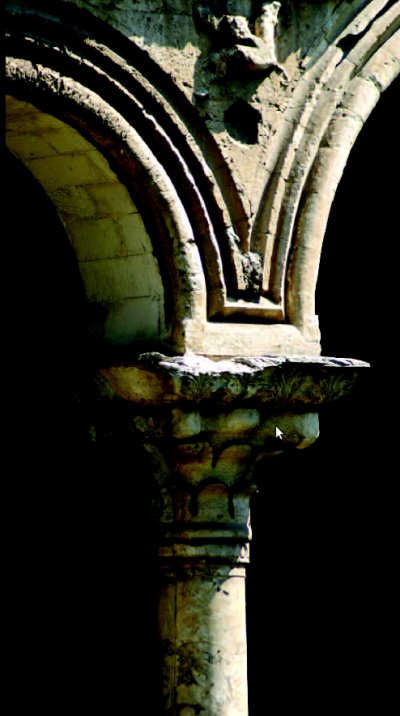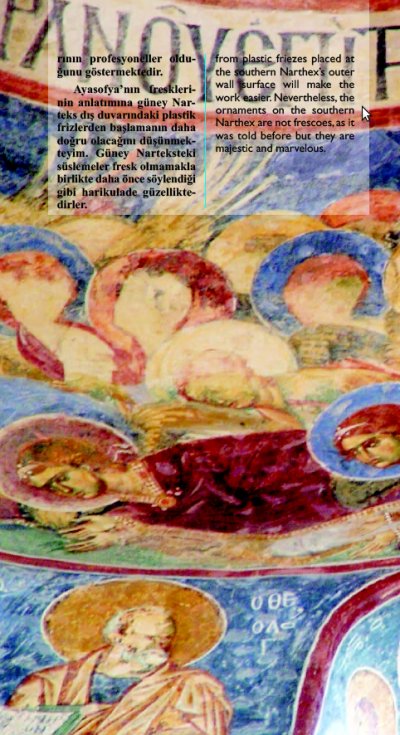
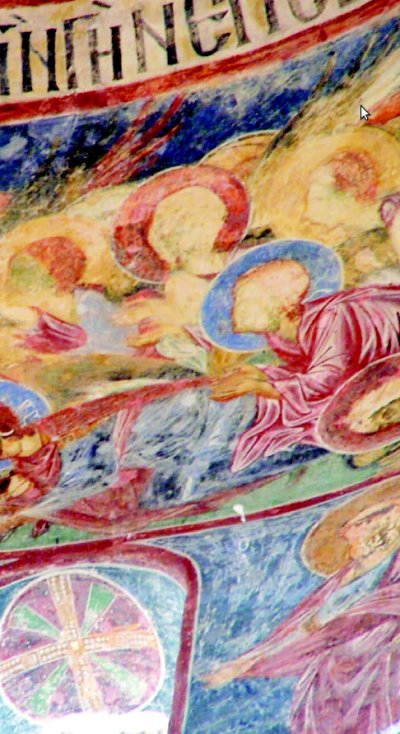
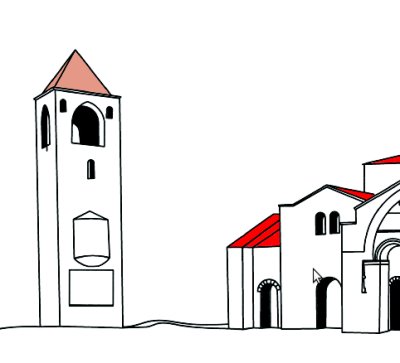
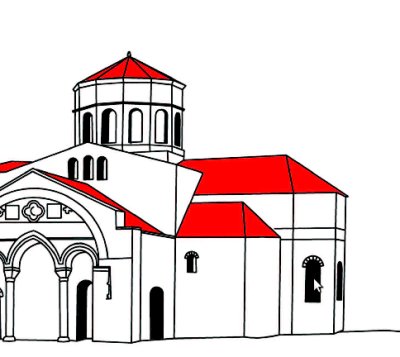
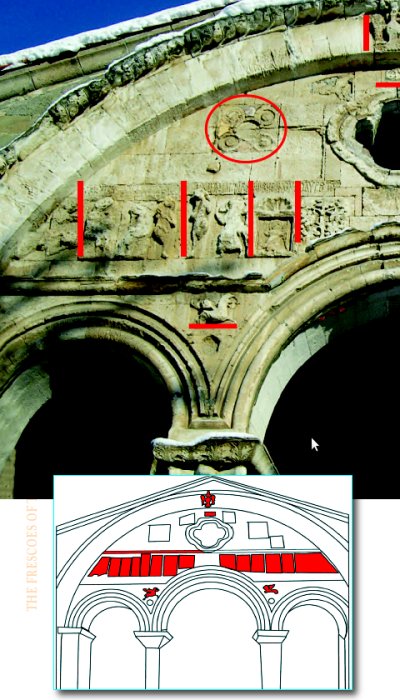
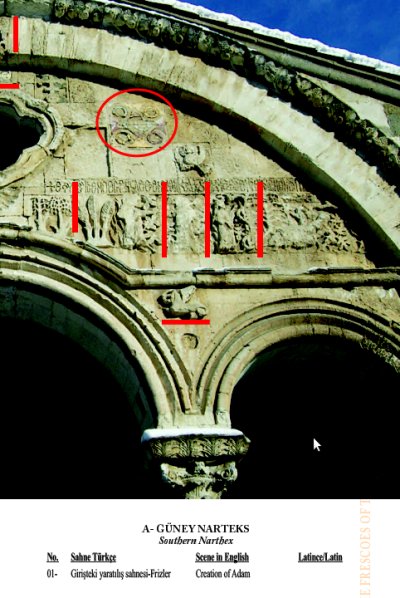
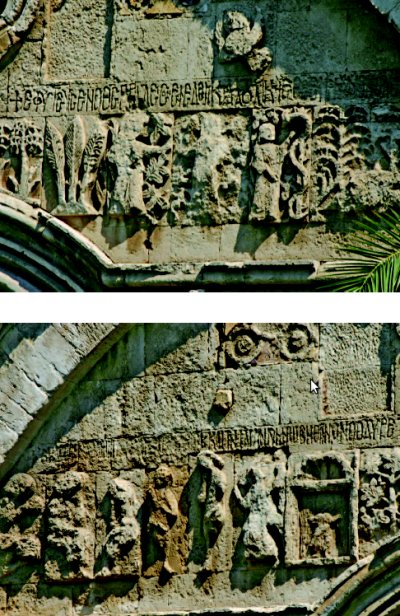
Ayasofya'nın Freskleri
The Frescoes of The Hagia Sophia
© Bütün hakları metin yazarına aittir.
Metin Yazarı / Author
İsmail KÖSE
Fotoğraflar / Photographs
İsmail Köse, Ali Ayvazoğlu, Metin Öztürk,
Yaşar Bedri Özdemir, Aydın Topcu
Çizimler / Drawings
ÖZKOL İNŞAAT / OZKOL CONSTRUCTION CO.
Mimar / Architect Ayşe Kakışım
İnşaat Mühendisi / Civil Engineer Deniz Günaydın
Çeviri / English Translation
İsmail Köse
Metin Danışmanı / Text Advisor
Rehberlik Hocası / Guiding Lecturer
M. Metin Güngör
İngilizce Kontrol ve Düzelti / English Check and Proof Reading
Steeve & Julia Prayors from UK
Pauline Samy from Australia
Yazarla İletişim / Contact to Author
ismailkosetr@hotmail.com
ismailkosetr@yahoo.com
Tasarım / Design
İsmail Köse / Hacer Yavruoğlu
Kapak / Cover
Trabzon Net Reklam Ajans
Emre Okutan
Baskı / Print House
İber Matbaacılık
0462 321 72 36
Trabzon, 2010
1. baskı
Dağıtım
Akademi Kitabevi
ISBN
978-605-61340-3-6
Copright AKADEMİ KİTABCILIK yayınıdır. Her hakkı saklıdır ve metin
yazarına aittir. Yazarından ve yayınevinden yazılı izin alınmaksızın bu
kitabın fotokopi veya diger yollarla kısmen veya tamamen çogaltılması,
basılması ve yayınlanması yasaktır.
İçindekiler / Contents
Ayasofya Müzesi / The Museum of Hagia Sophia
Çan Kulesi / Bell Tower
Freskler / Frescoes
Ayasofya'nın Freskleri / The Frescoes of The Hagia Sophia
A- Güney Narteks / Southern Narthex
B- Ayasofya'nın İçi Doğu Apsis ve Nefler / The Interior of Hagia Sophia Eastern Apsis and Naves
C- Kubbe / The Dome
D- Kuzey Duvar / Northern Wall
E- Duvar / Western Wall
F- Batı Narteks / Western Narthex
G- Batı Dış Narteks / Western Exo-Narthex
H- Kuzey Narteks / Northern Narthex
I- Çan Kulesi / The Belfry
Çan Kulesi'nin Freskleri / Frescoes of the Belfry
Ayasofya'nın Freskleri
Ayasofya'da bugüne kadar kalmayı başarabilmiş freskler aslında bir anlamda varlıklarını Osmanlı İmparatorluğu'nun hoşgörüsüne borçludurlar. Çünkü Osmanlı medeniyetinin kiliseleri camiye çevirirken fresklere zarar vermeyip sadece üstlerini badana ile kapatması pek çok freskin orijinal renk, kalite ve ihtişamında günümüze kalmasını sağlamıştır. Ayasofya'daki fresklerin tümü temizlenerek ortaya çıkartılmıştır. En iyi korunmuş durumda olan freskler, ana kilise kısmında, batı tarafındaki Narteks'te ve Çan Kulesi'nin şapel kısmındadır. Ayasofya fresklerinde belli oranda çevrimli öyküleme sistemine uyulmuş, fakat sahın'daki fresklerin bazıları Sumela Manastırı'nın Doğu Dış Cephesi ile Anakaya Kilisesindeki fresklerde olduğu gibi Narteks bölümünde tekrarlanmıştır. Yapının tonoz ve duvarlarındaki kalıntılar dikkatle incelendiğinde iç mekanın bir zamanlar bütünüyle fresklerle döşeli olduğu kolaylıkla görülebilmektedir.
Ben Ayasofya'da öykülendirilebilecek durumda olan 60'a yakın freskten oluşan bir envanter çıkarttım. İlerleyen bölümlerde bu freskler ve öyküleri Hıristiyanlık ve İslam açısından karşılaştırmalı olarak anlatılacaktır. Fresklerin yapılış tarihleri ile ilgili yazıt kalmamakla birlikte, D. Talbot Rice; kullanılmış olan stilin erken 14. yüzyıllara ya da muhtemelen 13. yüzyıllara ait olduğunu ve Bizans Rönesansını yansıttığını söylemektedir.
Ayasofya'daki freskler stil ve ikonografik özellikleri bakımından büyük önem arz etmektedirler. Renklendirme mükemmel olmamakla birlikte önceki dönemlerle karşılaştırıldığında büyük gelişme göstermiştir. Tam boydaki figürlerin ve sahnelerin arkasında koyu renkli loş gölgelendirme, fırtınalı gökyüzü, sarı-kahverengi, gri ve koyu yeşil arka planlar bulunmaktadır. Derinlik ve boşluk anlamında genel bir anlayış vardır ve modellemede muhtemelen batı etkisinin bir sonucu olarak kesin belli ölçütlere uyulmuştur. Bu etki büyük ihtimalle, özellikle Çan Kulesi'ndeki fresklerin yapıldığı dönemde Venedik ve Cenevizli tüccarların ticaret ilişkileri sırasında, 15. yüzyılın ortalarında gerçekleşmiştir.
Çalışmalar yerel ekol özelliklerini yansıtmakla birlikte, resimler ve boyama çok iyi bir şekilde yapılmıştır. Fresklerin renklerindeki canlılık çok iyi bir şekilde korunmuştur ve bunu da Osmanlı döneminde üzerlerinin badana ile kapatılmasına borçludurlar. Kitabe ve yazıtların gösterdiğine göre özellikle Çan Kulesi'ndeki freskler iki keşiş tarafından yapılmıştır ve bu iki keşiş 15. yüzyılın ortalarında harikulade freskler yapabilme kapasitesine sahiptiler. Bu durum bize Trabzon'da daha önce yaşamış olan ressamların ya da diğer bir deyişle fresk ustalarının profesyoneller olduğunu göstermektedir.
Ayasofya'nın fresklerinin anlatımına güney Narteks dış duvarındaki plastik frizlerden başlamanın daha doğru olacağını düşünmekteyim. Güney Narteksteki süslemeler fresk olmamakla birlikte daha önce söylendiği gibi harikulade güzelliktedirler.
The Frescoes of The Hagia Sophia
In Hagia Sophia the paintings visible at present owe their existence mostly to the Ottoman Empire's indulgence. Because the policy of the Ottomans while converting churches into mosques was not to obliterate the paintings but just cover them with a white paint allowing numerous frescoes to carry their original colour, quality and magnificence to the present day. All paintings in Hagia Sophia have been cleaned and exposed today. The most well preserved paintings exist today in the main body of the church, in the narthex to the west and in the chapel of the Bell Tower which stands not far from the west door. At Hagia Sophia the narrative cycle has been followed in a range of paintings, nowadays like Sumela Monastery's rock church's eastern masonry, some scenes in the aisle have been repeated at the narthex to the west. When ruins on arched vaults and walls were investigated carefully it was easily observed that, once upon a time the internal area of the church had wholly been covered by paintings.
I drew up an inventory in Hagia Sophia consisting of about 60 explainable frescoes. These paintings and their stories will be tackled comparatively in both Christianity and Islam throughout coming chapters. Though there is no inscription showing the date of paintings, D. Talbot Rice points out that the used style shows clearly enough that they belong at the latest to the 13th and probably to the 14th centuries and the paintings already suggest the manner of the Byzantine revival.
At Hagia Sophia the paintings are of considerable interest as regards their style and iconography. The colouring is also less fine, though it is considerably developed. Behind full length figures there are black and dark green backgrounds and have inky black, thunderous skies, which appear behind the scenes. There is a general sense of depth and space and a definite attempt at modeling, which may perhaps be due to western influence. This would be easily conveyed by means of Venetian or Genoese trading, throughout the mid 15th century.
The work essentially reflects features of local schools, though the paintings are nevertheless very well executed. The paintings have the attraction of being well preserved and owe this to being plastered over by the Ottomans. Inscriptions and signs show that especially in the bell tower paintings were executed by two monks and this shows that the artists were capable of executing this work well on into the 15th century. This case proves that, early wall-painters or artists living in Trabzon were doubtlessly professionals.
I think, starting Hagia Sophia's paintings' explanation from plastic friezes placed at the southern Narthex's outer wall surface will make the work easier. Nevertheless, the ornaments on the southern Narthex are not frescoes, as it was told before but they are majestic and marvelous.







01- Güney Narteks Girişteki Frizler
Kilit taşının hemen altında Komnenos Devlet simgesi doğuya bakan tek başlı kartal, onun altında Hıristiyanlık literatüründe Kutsal Ruh'u temsil eden kuyrukları birbirine geçmiş durumda iki güvercin, barışı ve dostluğu da simgeledikleri söylenmekte, kübik haç pencerenin her iki yanında Mithra kültüne dayanan ay ve yıldızlar, altında ise temsili güneş saati yer almaktadır. Batıdaki zamanla düşmüş olmakla birlikte, her iki yanda apokaliptik hayvan figürleri ve altta bir sıra yazı dizisi yer almaktadır. Hemen bir alt sırada oldukça güzel bir şekilde simetrik olarak işlenmiş Eski Ahit'in Tekvin (yaratılış) sahneleri canlandırılmıştır. Sahnelerin canlandırması bakış açısına göre sağdan sola doğru yapılmıştır.
Eski Ahit'in Tekvin Babı'na göre; Rab Tanrı önce insanı (Adem) topraktan yaratmış ve burnuna yaşam soluğunu üflemişti. Daha sonra Aden'de bir bahçe dikerek onu oraya yerleştirir. Frizlerde ilk sahnede insanın (Adem) yaratılışı ve yerleştirildiği bahçedeki bitkiler canlandırılmıştır. Bahçenin ortasından bir ırmak akmakta ve Pişon, Gihon, Dicle ve Fırat adlarında dört kola ayrılmakta idi. İnsana, iyilik ve kötülük ağacı hariç tüm meyvelerden yemesi için müsaade edilmiş, yasak ağaçtan yediği gün öleceği söylenmişti.
Tanrı bir gün insana uyku vererek onun kaburga kemiğinden kadını (Havva) yarattı. Yaratılan hayvanların en kurnazı yılan bir gün kadına gelerek onu kandırdı ve yasak meyveden yerlerse ölümsüz olacaklarını söyleyerek yasak meyveden yemesini sağladı, kadın meyveden kocasına da yedirir. Frizde üçüncü sahnede yılan Havva'yı kandırırken görülmektedir. Bu zamana kadar cennette çıplak olan ve utanma duygusu olmayan Adem ve Havva'nın meyveden yedikten sonra gözleri açılır ve çıplak olduklarını görünce incir yapraklarından elbise dikerek kendilerine önlük yaparlar.
Frizde birinci kısımdaki son sahnede görünen incir yaprakları Adem ve Havva'nın utançlarını ve örtünme çabalarını göstermektedir. Adem karısına tüm insanlığın annesi olduğu için Havva adını verir. Yaptıklarına ceza olarak Tanrı tarafından Aden bahçesinden (cennetten) kovulurlar. Tanrı'nın emri ile toprağı işlemeye başlarlar, önce Kayin daha sonra'da Habil isminde oğulları olur. Kayin çiftçi, Habil is çobandır. Kayin Tanrı'ya sunacağı sunularda cimri davranınca sunuları reddedilirken, cömert davranan Habilin sunuları kabul edilir. Bu duruma çok sinirlenen ve kardeşini kıskanan Kayin birgün tarlada Habil'i öldürür. Frizde en sonda canlandırılan sahnede ayakta durmakta olan figür Kayin, yerde yatmakta olan da öldürülmüş olan Habil'dir.
Yaratılış frizlerinin üzerindeki yazı kuşağının sol taraftaki Paskalya öncesi okunan Pazar İlahisi'dir. Sağ taraftaki ise Tevrat'ın Tekvin Babı'ndan alınmış olan Adem'in yaratılışını anlatan kısımdır.
01- Friezes on The Southern Narthex Wall
Almost under the keystone, there is a Comnenus State symbol single headed eagle looking to the east. Under this eagle holy in Christianity and representing the Holy Spirit, there are two pigeons with tails entwined. It is said they also symbolize peace and friendship in the lands. At both sides of the cubic cross shaped window there are crescent and stars based on the Mythra cult and under them there is a sundial. Though one of them to the west has fallen down over time, at both sides there are apocalyptic creature figures and under both there is an inscription register. Below the inscription register, creation scenes from the Old Testament's Genesis Chapter are carved symmetrically. The scene is carved from right to left by viewing angle. In the Monastery of Sumela the same scenes are painted but this time depiction starts from left to right. Nowadays both include a very detailed narration. The Genesis scene in Sumela has the advantage of being done by painting depicted in a more detailed and understandable manner. In Sumela also creation of the earth in the first register to the east surface is depicted very well. From right to left, although the first scene has partly lost its features, it animates the creation of Adam and Eve.
One day, God caused the man to fall into a deep sleep; and while he was sleeping, he took one of the man's ribs and closed up the place with flesh. Then the God made a woman (Eve) from the rib he had taken out of the man. The serpent was more crafty than any of the wild animals God had made. One day the serpent came to the woman and deceiving her told her that if she ate fruit of the prohibited tree she would be like God knowing good and evil. The women ate the fruit and also gave some to her husband and he also ate it. In the third scene from right to left, the serpent deceiving the woman can easily be seen. Until this time man and woman were naked and had felt no shame. Then the eyes of both of them were opened, and they realized they were naked so they sewed fig leaves together and made coverings for themselves. In the last scene on the first part of the frieze, fig leaves show the shame of Adam and Eve and their struggle to make coverings for themselves. Adam named his wife Eve because she would become the mother of all the living. As a punishment for not to listening to God's command, they were both expelled from the Garden of Eden to work the ground from which man had been taken. Adam and Eve first had a son named Cain and later another son named Abel. Cain was working the soil and Abel was keeping flocks. When they offered their offerings to God, Cain was stingy and brought some of the fruits of the soil whereas Abel had brought an offering from some of the firstborn of his flock. Cain's offerings were not accepted by God whilst Abel's were favoured. Cain was very angry, and his face was downcast and one day he killed his brother in the field. On the frieze in the last scene, the standing figure is Cain killing his brother and the figure lying on the ground is Abel killed by him.
Above the Creation frieze there are linear inscriptions. The inscription to the left is about Lenten Triodion, and the other to the right is from Genesis, creation of Adam.
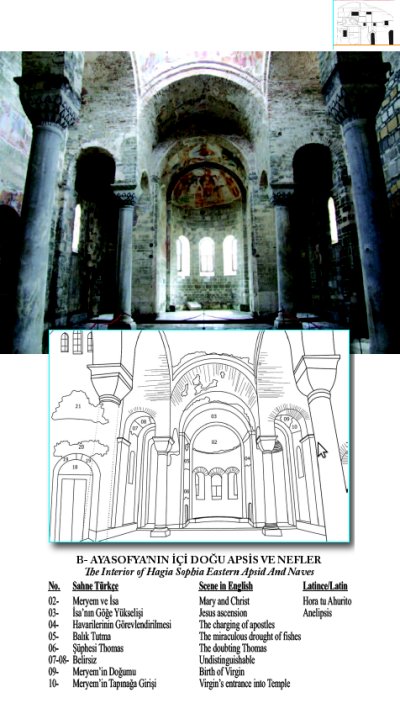
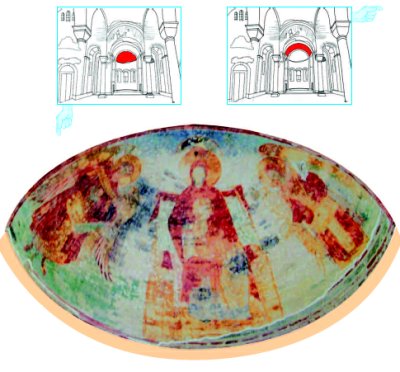
02- Meryem ve İsa (Apsis)
Kiliselerin apsislerinde genellikle tahtta oturan Meryem ve kucağında henüz çocukluk çağında olan İsa freski işlenir. Şayet fresk'te Meryem çocuk İsa'yı sol omzunda kendine yaslamış bir durumda ise bu fresklere/ikonlara; rehber, yol gösteren anlamına gelen Hodigitria Meryem adı verilir. Çocuk İsa Meryem'in karnı hizasında ise bu fresklere/ikonlara; hiçbir yere sığmayan tanrıyı karnına sığdıran anlamında Hora tu Ahurito yada Karye Meryemi adı verilir. Ayasofya'nın apsisindeki freskte Meryem tahtta oturmaktadır ve çocuk İsa kucağındadır.
02- Mary And Christ (Apse)
In the apses of churches, usually the scene of enthroned Mary and Christ child on her knee is depicted. In the scene if Mary holds the Christ child on her left shoulder these frescoes/icons are called Odegetria Mary meaning guide, leader. If Christ Child is depicted on Mary's stomach those frescoes/icons are called Hora tu Ahurito or Mary of Chora meaning sheltering the Eternal God in her stomach. In the apse of Hagia Sophia Mary sits on the throne and the Christ Child is on her knee, this is called the Platytera of The Apse.
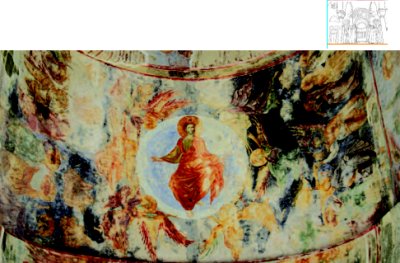
03- İsa'nın Göğe Yükselişi (Anelipsis)
Genelde göğe yükselme sahnesi apsis tonozunun tam ortasına resmedilir ve bu sahne anelipsis olarak adlandırılır. Her iki alt tarafta Havarilerin kutsanması yada görevlendirilmesi sahnesi ile balık tutma mucizesi sahneleri bulunur. Anelipsis sahnesinde İsa mutlaka mandorla (badem biçimli desen) içinde çizilir. Ayasofya'da da durum bu şekildedir. Göğe yükselmekte olan İsa'nın her iki yanında, beşik tonozun güney yatay duvarında görevlendirilen havariler, kuzey tarafında balık tutma mucizesi vardır. İsa mandorla içinde beşik tonozun tam ortasında yer almaktadır. Ayasofya'daki anelipsis sahnesi, diğer kiliselerdeki anelipsis sahnelerinin tüm özelliliklerini yansıtır. Sahnede; göklere doğru çekilecek olan İsa için melekler gökleri dürüp bükmekte, kutsal ölüler, azizler ve azizeler bir kenardan bu buluşmayı izlemektedirler. Anelipsis'in gerçekleştiği gün Hıristiyan Yortu takviminin kırkıncı günüdür; göğe çekilme bu günde olmuştur.
03- The Departure (Anelipsis)
The departing scene is generally depicted on the centre of the apse vault and this scene is called anelipsis. Below both sides of this scene the blessing of and charging of apostles and fish miracle scenes are depicted. In anelipsis scenes Christ is depicted within an almond shaped mandorla. In Hagia Sophia the situation is the same. At both sides of departing Christ, to the southern wall's horizontal side charged apostles, to the northern wall's horizontal side fish miracle scenes are depicted. Christ within the mandorla placed at the centre of the barrel vault. The anelipsis scene in Hagia Sophia reflects all features of ordinary anelipsis scenes in other churches. In the scene angels preparing the sky for Christ's departure, holy deaths and saints at the sides watching Christ's departure and being taken up into heaven. The day of anelipsis is the 40th day of Christian religious holiday calendar and departure of Christ occurred on this day.
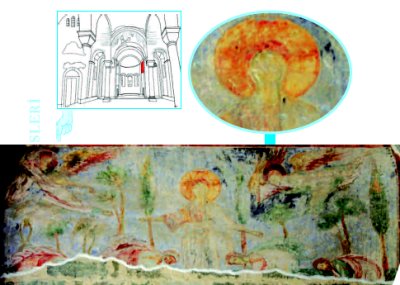
04- Havarilerin Görevlendirilmesi / Kutsanması
Havarilerin görevlendirilmesi sahnesi de genellikle Analipsis'in diğer alt yanında yer alır ve havariler ile toplu buluşma niteliğinde olduğu için de havarilerin kutsanması olarak da adlandırılır. Sahnede bir buluşma, bir cennet görünümü uyandırır tarzda, havariler İsa'nın önünde huşu ile eğilmişlerdir. İsa iki eliyle havarilerini kutsamaktadır ve kendilerine pek çok dilin verildiğini, artık dünyanın her yerine gitmeleri gerektiğini söylemektedir.
04- The Charging / Blessing of Apostles
This scene is also depicted on another side below the anelipsis and because all eleven apostles are in the scene it is also called blessing of apostles. In the scene there is a meeting, heavenly view, and apostles bowing before Christ in respect. Christ with his arms outstretched on both sides blessing his apostles and saying to them, numerous languages have been given to them, to go to everywhere on earth.
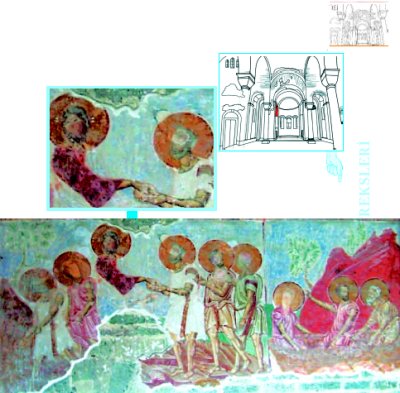
05- Balık Tutma Mucizesi
İsa göğe çekildikten sonra Taberiye Gölü'nde balık tutan havarilerine görünür. Petrus ve diğer altı havari balık avına giderler. Gece boyunca bir şey avlayamazlar, sabah İsa Taberiye'nin kıyısında görünür, havariler onun İsa olduğunu anlamazlar. İsa onlara balıkları olup olmadığını sorar, yoktur. İsa "Ağı sandalın sağ yanına atın" der, ağ balıkla dolar. Bu olay İsa'nın mucizelerinden biri değil de, sembolik şekilde havarilerini görevlendirmesi olarak da kabul edilmektedir.
05- The Miraculous Draught of Fishes
After Christ's being taken up into heaven he appeared again to his disciples, by the Sea of Tiberias. Simon Peter and another six apostles together went out to fish, but that night they caught nothing. Early in the morning, Christ stood on the shore, but the apostles did not realize that it is him. Christ asks them whether do they have fish or not - there is no fish. He says them; "to throw their net on the right side of the boat" and they will find some. When they did, they were unable to haul the net in because of the large number of fish. This scene is recognized not as a miracle of Christ but symbolically his charging of apostles.
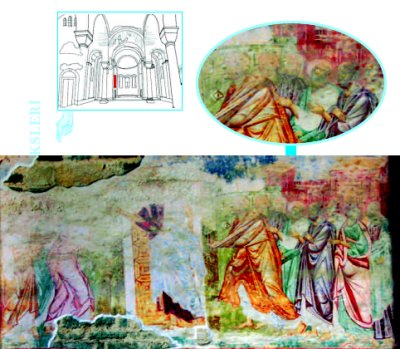
06- Şüpheci Thomas
İsa dirilişinden sonra havarilerine görünmüş fakat o anda orada olmayan Thomas İsa'yı görmemiştir. Diğer havarilerin kendisine İsa'yı gördüklerini söylemeleri üzerine, Thomas; "Onun ellerinde çivilerin izini görmedikçe, çivilerin izine parmağımla dokunmadıkça ve elimi böğrüne sokmadıkça inanmam" demişti. Bu olaydan sekiz gün sonra Thomas ve diğer havariler bir evde otururken İsa gelip aralarına oturur, Thomas'tan parmağını uzatarak ellerine bakmasını, yaralı olan böğrüne dokunmasını ister. İsa'nın yaralarına dokunan Thomas onun dirildiğinden emin olur.
06- The Doubting of Thomas
After his rising Christ had appeared to his apostles but Thomas one of the twelve was not with the others when Christ came. When other apostles told him that they have seen Christ, Thomas had said "unless I see the nail marks in his hands and put my finger where the nails were and put my hand into his side, I will not believe it." After eight days, Thomas and other apostles were in the house, Christ came and stood among them, asking Thomas to put his finger his nail marks and his hand into his side. Thomas after touching Christ's nail marks and side loses his doubts being sure of Christ's resurrection.
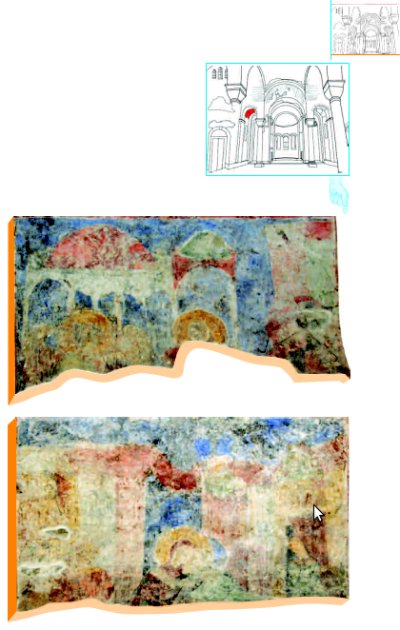
Fresk No: 07- 08
Numaralandırmamıza göre 7 ve 8 numaraya denk düşen Kuzey yan nef apsisi beşik tonozdaki freskler anlam verilemeyecek durumdadırlar ve renkleri zamanın etkisine dayanamayarak özelliklerini kaybetmişlerdir.
Fresk No: 07- 08
According to my numbering, 07 and 08 numbered scenes, placed on the north side of the nave apse in a barrel vault, have disappeared so much that it is impossible to figure out explanations of them.
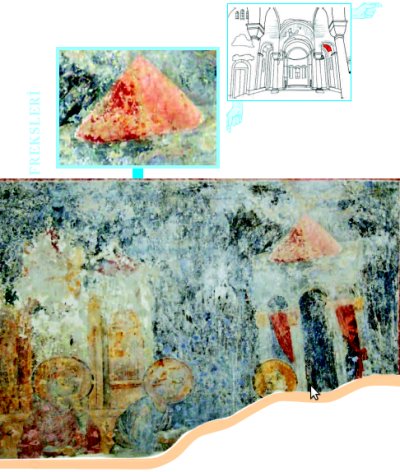
09- Meryem'in Doğumu
Anna ve Yuvakim'in çocukları olmamaktadır. Yuvakim bir çocuğu olması için çobanlarla birlikte yaşar ve kırk gün oruç tutar. Anna'ya bir çocuğu olacağı müjdesi verildikten sonra, bir kızları doğar, adını Meryem koyarlar.
09- Birth of Mary
Anna was barren, she and her husband Yovakim could not have a child. To have a child Yovakim lives with shepherds and throughout forty days he fasts. After Anna announces that she will give birth to a child, she gave birth to a daughter and both named her Mary.
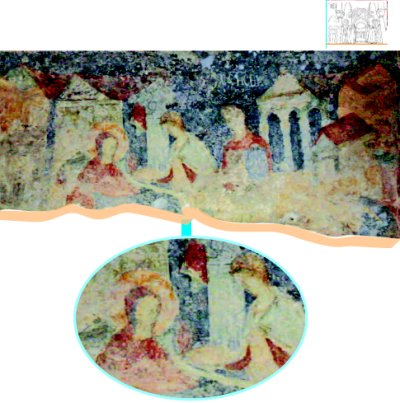
10- Meryem'in Tapınağa Girişi
Birinci yaş gününde Meryem, hahamlar ve din bilginleri tarafından takdis edilmişti. Meryem üç yaşına geldiğinde ebeveynleri tarafından 12 yaşına kadar eğitim göreceği tapınağa, başhaham Zekeriya'ya götürülür.
10- The Entry of Mary Into Temple
By her first birthday Child Mary had been sanctified by priests and teachers of the law. When Mary was three years old her parents brought her to the temple, to head priest Zachariah where she would be trained until the age of 12. In Hagia Sophia the Birth of Mary and her Presentation to Temple is depicted on the barrel vault in the southern nave apse.
Vafiyadis Haralambos 1965 yılında yayınlanan "Sumela Manastırı" adlı kitapta Ayasofya'nın naos bölümündeki opussectaile tarzında işlenmiş yer mozaiğinin ortasında, kubbenin hemen altında Komnenoslar döneminden kalma kralların zaferini anlatan kartal, üzüm asması ve tavşan motiflerinin bulunduğu mermer bir işleme olduğunu söylemektedir. Arma şeklindeki işlemenin figürleri mermer üzerine kazınmıştı ve 1860 yılında Kromni'de inşaat işçiliğiyle uğraşan Hacı Murat Vafiyadis tarafından yerinden alınarak Sürmene'nin Mancandan Köyündeki kiliseye götürülmüş ve buradaki avizenin altına yerleştirilmiştir. Mermer işleme Mübadele esnasında, 1924 yılında Yunanistan'a götürülmüştür. Şuan Selanik'te Rotondo Müzesi'nde sergilenmektedir. Mermer üzerindeki işleme Selanik'te bir cemiyetin de resmi amblemi olarak kullanılmaktadır.
Vafiyadis'e göre; Mermer işleme üzerindeki Kartal; Komnenos Krallığını, Kartalın Tavşanı yenmesi Komnenoslar'ın düşmanlarını yenilgiye uğratmasını simgelerken, üzüm asması Komnenoslar'ın bölgeye hakimiyetlerini ifade etmektedir.
Vafiyadis Haralambos at his book "Soumela Monastery" published in 1965 argues that, in the centre of Hagia Sophia's nave at the middle of ground mosaic ornamented in opussectile style, under the main dome there was an heraldic belonging to Comnenus era. The heraldic was carved on a marble block showing triumphs of Comnenus Kings consisting a eagle, rabbit and grapevine. In 1860 the heraldic was taken by Hacı Murat Vafiyadis who was from Kurum working in buildings and brought and placed at the centre of a church in Surmene's Manca Village. The heraldic has been brought to Greece in 1924 at the time of population exchange. It is in Thessaloniki at Rodonto Museum and also used as official emblem of a society in Thessaloniki.
According to Vafiyadis; eagle carving on the marble was symbolizing Comnenus Kingdom, Eagle's eating the Rabbit was symbolizing Comnenus' victory against their enemies and the Grapevine was symbolizing Comnenus' sovereignty in the region.
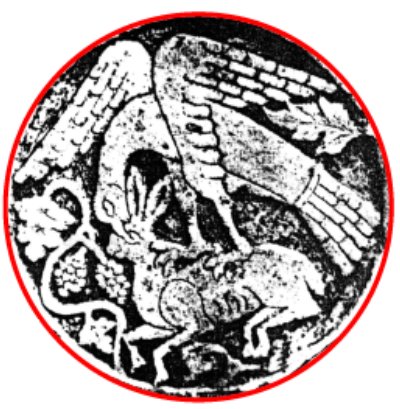
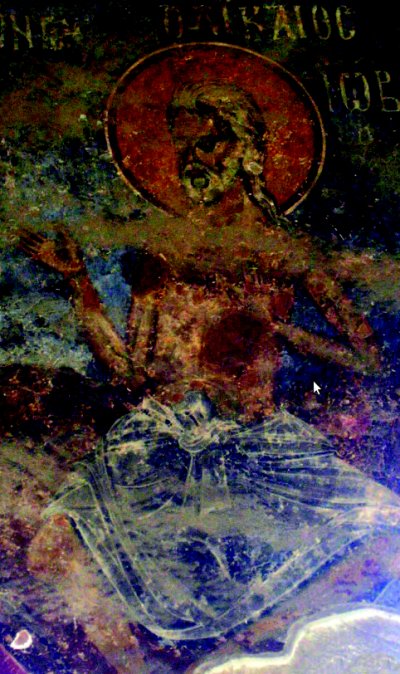
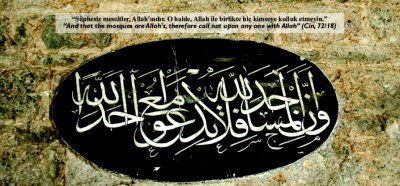
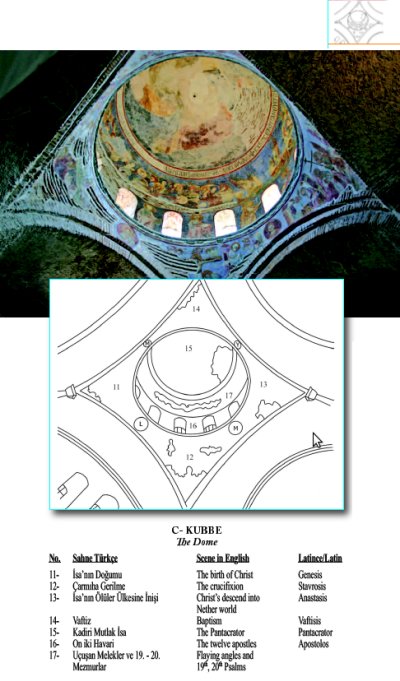
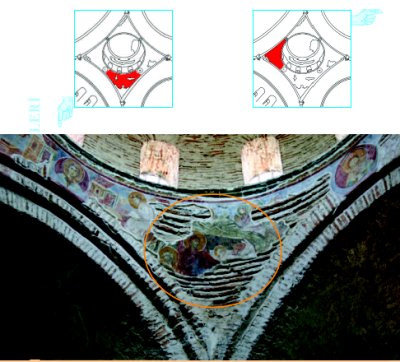
11- İsa'nın Doğumu (Genesis)
Meryem İsa'ya hamile iken, Roma İmparatoru Sezar Augustus, bir ferman yayınlayarak tüm imparatorluk topraklarında nüfus sayımı yapılmasını emreder. Nüfus sayımında herkes kendi topraklarında yazılacaktır. Meryem'in kocası Yusuf da, Davut'un soyundan olduğundan Meryem'i de yanına alarak, Celile'nin Nasıra kentinden kalkarak Beytüllahim'e gider. Aile handa yer olmadığı için ahırda gecelemek zorunda kalır. O gece İsa ahırda doğar ve kundağa sarılarak yemliğe yatırılır. İsa'nın doğumuna eşlik eden Ebelerin adları Salomi ve Mea'dır. Ebelerden apokrif metinlerde bahsedilir.
11- The Nativity - Birth of The Christ (Genesis)
While Mary was pregnant with Jesus, Caesar Augustus issues a decree that a census should be taken of the entire Roman world. Everyone goes to his own town to register. Mary's husband Joseph goes with Mary up from the town of Nazareth in Galilee to Bethlehem in Judea. There was no room for them in the inn, they had to spend a night in the stable. That night Christ was born, wrapped in clothes and placed in a manger. The names of the midwives accompanying the birth of Christ were Salome and Mea. Apocryphal manuscripts tell about midwives.
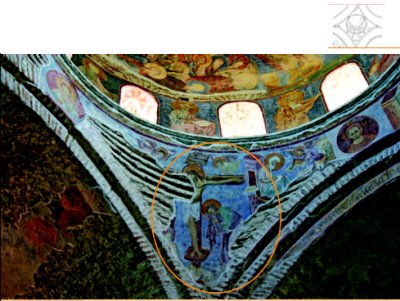
12- İsa'nın Çarmıha Gerilmesi (Stavrosis)
Sahnenin kuzey tarafında İsa'nın ayaklarının yanında yas tutan kişi Havari Yuhanna'dır. Çarmıh sahnelerinde genellikle İsa'nın annesi Meryem, Mecdelli Meryem ve Klopas'ın karısı Meryem görülür ki bunlara Emirofori -kutsal yağ taşıyıcılar- denir.
İsa'yı yargılayıp ölüme mahkum ettikten sonra askerler İsa'ya işkence ederler, kaftanını üzerinden çıkarıp ona yine kendi giysilerini giydirirler ve çarmıha germek üzere, onu alıp götürürler. Dışarı çıktıklarında Simun adında Kireneli bir adama rastlarlar, İsa'nın çarmıhını ona zorla taşıtırlar. "Golgota", yani Kafatası denilen yere vardıklarında içmesi için İsa'ya ödle karışık şarap verirler. İsa bunu tadınca içmek istemez. Başının üzerine, "Yahdilerin Kralı" yazan bir suç yaftası asarlar. İsa'yla birlikte, biri sağında öbürü solunda olmak üzere iki haydut da çarmıha gerilmişti. Şaraba batırılmış bir süngeri zufa dalına takarak onun ağzına uzatırlar Loginos isimli asker İsa'nın böğrünü mızrakla delerek ölüp ölmediğini kontrol eder.
12- The Crucifixion (Stavrosis)
The crucifying is only partly visible, to the north of the scene, beside Christ's feet the mourning figure is Apostle John weeping unrestrainedly. In crucifying scenes usually three Marys, Mary, Mary the wife of Clopas and Maria Magdalene are pictured who are called Emirofori -blessed oil carriers-. John is always depicted in almost all crucifixion scenes and he does not hold a book. The Mary holds up her hands in horror and pain. The feet of Christ are attached to the cross side by side, with two nails. On the cross, above Christ's head the written charge against him is placed: "The King of the Jews".
After Christ was judged and sentenced to death, soldiers stripped, tortured and put a scarlet robe on him. After making fun of him, they took off the robe and put his own clothes on him. As soldiers were leading him to be crucified they met a man from Cyrene, named Simon, and forced him to carry the cross. When they arrived at a place called Golgotha (meaning The Place of the Skull), they offered Christ wine to drink, mixed with gall, but after tasting it, he refused to drink it. They crucified him and fastened above his head Pilate's notice saying that he was King of the Jews. Two robbers were also crucified with Christ one on either side of him. One man gets a sponge, fills it with wine vinegar, puts it on a stick and offers it to Christ to drink and one of the soldiers named Loginos thrusts his spear into Christ's breast.
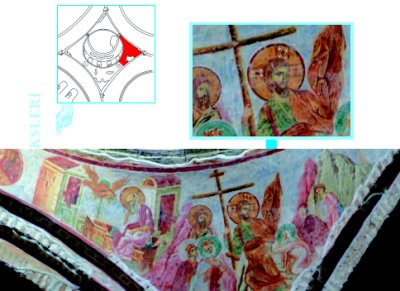
13- İsa'nın Ölüler Ülkesine İnişi (Anastasis)
Anastasis Yunan dilinde; dirilmek, ayağa kalkmak anlamlarına gelir. Anastasis sahnelerinin temeli apokrifal metin olan Nikodemus İncilidir ve büyük ihtimalle antik Yunan inanışlarının etkisi ile erken Hıristiyan mitosundan kaynaklanmaktadır. İsa defnedildikten sonra dirilmeden önce ölüler ülkesine iner. Bu inişin amacı, Adem'den bu yana, vaftiz edilmedikleri için orada bekleyen ruhları kurtuluşa götürmektir. Anastasis sahnelerinde İsa ölüler diyarının kapılarını kırarak genellikle sol eli ile Adem'i diğer eli ile de Havva'yı kurtarır. Adem ve Havva'nın kurtarılması insanlığın kurtuluşunu sembolize eder çünkü bu ikili insanlığın ilk atalarıdır.
13- Christ Descend Into Nehter / Underground World (Anastasias)
In Greek language the term Anastasias means; rising, resurrection. The source of anastasias scenes is the apocryphal manuscript Nicodemus Gospel and probably reflects the Ancient Greeks believing it derived from early Christian myths. Christ, after his burial and before his resurrection, descends into hell. The aim of his descending, starting from Adam the first human, was to achieve the salvation of spirits who were waiting there because they had not been baptized. At anastasias scenes Christ breaks open deaths' country's doors and generally with his left hand he redeems Adam and with his right Eve. Because Adam and Eve were the first parents of all humanity redeeming them symbolically implies salvation of humanity.
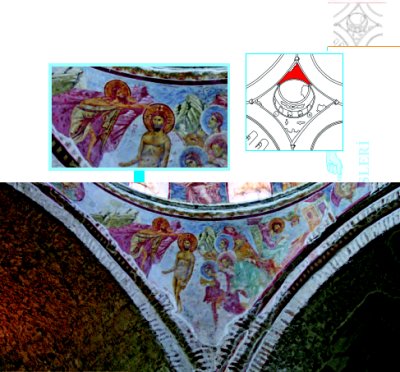
14- İsa'nın Vaftizi ( Vaftisis)
İsa ayakları yürüyüş pozisyonunda çıplak olarak Şeria Nehri'nde kendisinden altı ay büyük kuzeni Yahya tarafından vaftiz edilmektedir. Batı tarafında İsa'nın hemen arkasında üç tane melek havlu tutmaktadır ve Şeria Nehri perspektiften İsa'nın arkasında bulunmaktadır. İsa, Yahya tarafından vaftiz olup sudan çıktıktan sonra gökler açılarak, Tanrı'nın ruhu güvercin şeklinde gelerek İsa'nın omzuna konmuş ve göklerden gelen ses, "Sevgili oğlum budur ondan hoşnudum" demiştir. Vaftizden sonra Yahya'nın misyonu biter, Yahya Kudüs valisi Hirodes Antipa tarafından başı kesilmek suretiyle öldürülür.
14- The Baptism (Vaftisis)
In the scene, Christ walking naked in the River Jordan is being baptized by his six months older cousin John. To the west are three angels the foremost whom holds Christ's garment in readiness. The river is in perspective behind Christ. As soon as Christ was baptized, he went up out of the water, at that moment heaven was opened, the Spirit of God descends like a dove and lights on Christ. A voice from heaven says; "This is my Son, whom I love; with I am well pleased". After baptism the mission of John was over and he was killed by the governor of Jerusalem Hirodes Antipa. In Islamic sources there is no information related to baptism.
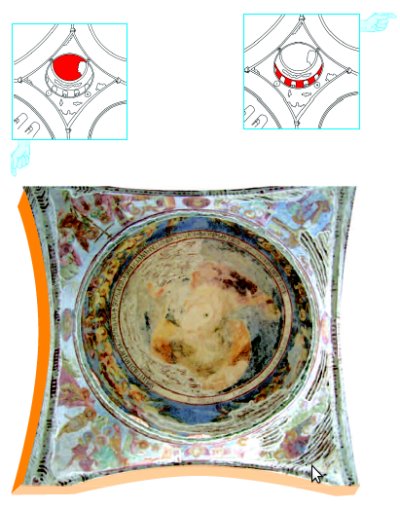
15- Kadir-i Mutlak İsa ( Pantakrator)
Her şeyin egemeni, evrenin hakimi anlamlarına gelir. Pantakrator resimleri, yapının en yüksek, görkemli yerine, genellikle kubbeye işlenir. Resim çevresinde madalyonlar içinde melekler yada azizler yer alır ve İsa'nın elinde bazen bir metin tuttuğu görülür. İsa'nın sağ eli Ayia Triada'yı -teslis, kutsal üçleme- gösterir biçimde resmedilir. Pantakrator freskleri İsa'nın tanrısal gücünü simgeler.
15- The Lord of Cosmos (Pantacrator)
Pantocrator means the ruler of all or celestial emperor. Pantocrator scenes are depicted at the most majestic parts of temples, generally on the central dome. Surrounding pantocrator figure in medallions angels or saints are depicted and sometimes Christ handles a manuscript. Christ's right hand is depicted in the shape of showing ayia triada -Holy Trinity- Pantocrator scenes symbolize Christ's divine power.
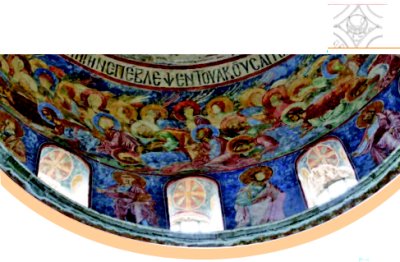
16- On İki Havari
Havari sözcüğü Yunanca "elçiler" anlamındaki "apostolos" sözcüğünden türer. Havariler İsa'nın kendisine seçtiği yoldaşlarıdır ve ölümünden sonra Hıristiyanlığın yayılmasında büyük rol oynamışlardır. On iki havarinin her biri sembolik olarak İsrail'in on iki kabilesini temsil ederler ve yeniden doğan İsrail'i müjdelerler.
On iki havari, Ayasofya'nın 12 köşeli olarak inşa edilmiş olan soğan/konikal kubbesinin köşe aralarındaki boşluklara işlenmiştir. Tamamı görünür durumda olmasa bile oldukça iyi bir şekilde korunmuşlardır. Havarilerin isimleri şu şekildedir:
12 HAVARİ
1. Simun Petrus (Yunusoğlu
2. Andreas (Petrus'un kardeşi)
3. Yakup (Zebedi'nin oğlu)
4. Yuhannis (Zebedi'nin oğlu)
5. Flippos
6. Bartholomeos
7. Matta (Vergi Tahsildarı)
8. Thomas
9. Alteoğlu Küçük Yakup
10. Simon (Yurtsever)
11. Yudas (Yahuda Taddeus)
12. Iskariyot Yahuda (İsa'yı ele veren)
16- The Twelve Apostles (Disciples)
The word apostle derives from Greek word "apostolos" meaning "messengers". Apostles are companions of Christ he has chosen and after Christ's death their works are vital for spreading of Christianity. Each of twelve apostles symbolically represents one of the twelve tribes of Israel and they announce the new born Israel.
Twelve apostles in Hagia Sophia have been depicted between windows in spaces in the dodecagonal shaped conical dome. Though all of them are not visible, they are extremely well preserved. Their names are as follows:
THE TWELVE DISCIPLES
1. Simon (called Peter)
2. Andrew his brother
3. James son of Zebedee
4. John, Jame's brother
5. Philip
6. Bartholomew
7. Matthew the tax collector
8. Thomas
9. James the son of Alphaeus
10. Simon the Zealot
11. Thaddaeus Judas
12. Judas Iscariot, who betrayed Christ.
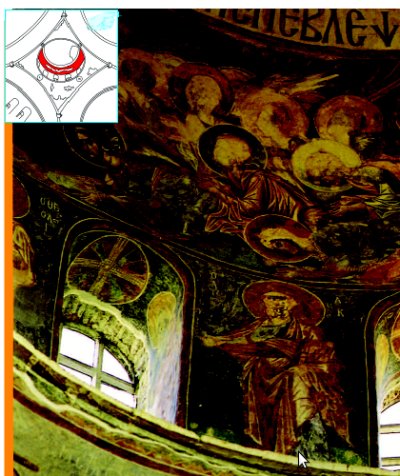
17- Kubbe'de Uçuşan Melekler ve 19. ve 20. Mezmurlar
Pantakrator figüru altında bir kuşak halinde Mezmurlar (Zebur) kitabından alınmış bir yazı kuşağı görülür. Bu yazı kuşağında 19 ve 20. ilahiler olduğu gibi yazılmıştır. Kuşağın altında ise melekler frizi yer alır. Mezmurlar ilahi ve dua kitabıdır. Uzun süre içinde farklı yazarlar tarafından yazılmıştır ve övgü, tapınma ilahileri, ağıtlar, yardım, korunma ve kurtuluş duaları şeklinde çeşitlere ayrılırlar. 19. Mezmur 14 bölümden oluşur ve "Gökler tanrının görkemini açıklamakta, gökkubbe ellerinin eserini duyurmakta, gün güne söz söyler, gece geceye bilgi verir, ne söz geçer orada, ne de konuşma sesleri duyulmaz..." şeklinde başlayarak devam eden bir övgü ilahisidir.
20. Mezmur ise; 9 bölümden oluşur ve; "Sıkıntılı gününde Rab seni yanıtlasın, Yakup'un tanrısının adı seni korusun, yardım göndersin sana kutsal yerden, Siyon'dan destek versin, sunularını anımsasın..." şeklinde başlayarak devam eden bir dua ilahisidir.
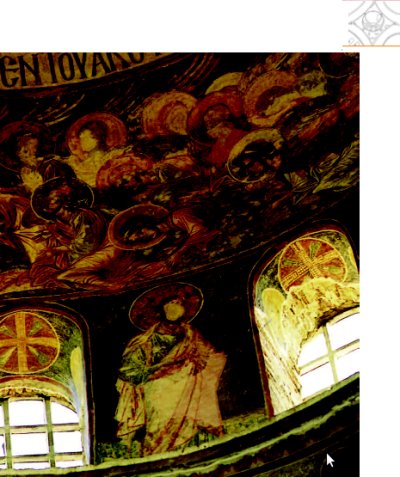
17- Flying Angels in The Dome, 19th & 20th Psalms
Under the pantocrator figure, there is a circular inscription belt taken from the Psalms chapter of the Old Testament. In this circular inscription belt, 19th and 20th psalms have been depicted in their entirety. Under this circular inscription belt there is an angels' scene. Psalms is a hymn and prayer book. Throughout a long period it was written by different authors and includes, praise, worshipping psalms and mourning, assistance, protection and salvation prayers. The 19th Psalm is a praise psalm consisting of 14 verses and starts as "The heavens declare the glory of God; the skies proclaim the work of his hands. Day after day they pour forth speech; night after night they display knowledge..." and goes on.
The 20th Psalm consists of 9 verses and it is a prayer psalm starting as; "May the Lord answer you when you are in distress; may the name of the God of Jacob protect you. May he send you help from the sanctuary and grant you support from Zion..."
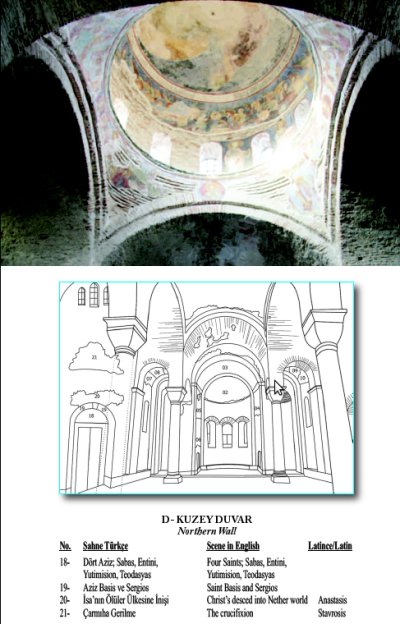
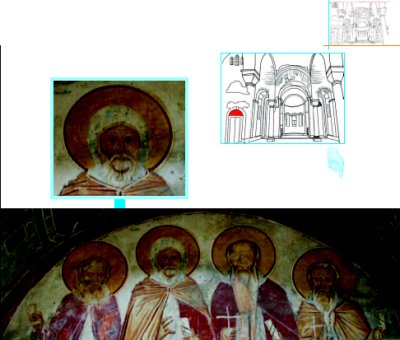
18- Dört Aziz
Kuzey giriş kapısı üzerindeki kemerde batıdan doğuya doğru dört aziz, Aziz Sabas, Aziz Entini, Aziz Yutimison ve Aziz Teodisyas figürleri oldukça canlı renklerle işlenmiştir. Sabas ve Yutimison koyu kırmızı pelerin giyinirken, Entini ve Teodisyas daha açık renk pelerinle resmedilmişlerdir. İlk iki aziz sağ elleri ile teslis işareti yaparken, Yutimison ve Teodisyas ellerinde haç tutmaktadırlar. Dördünün de sol elinde kağıt tomarları vardır.
18- Four Saints
Underneath of arch on the northern entrance door from west to east are four saints, St. Sabas, St. Entini, St. Yutimison and St. Teodisias have been depicted with extremely living colour. St. Sabas and St. Yutimison are clothed with claret cloaks, St. Entini and St. Teodisias have been clothed with lighter coloured cloaks. First two saints' right hands show the trinity whilst the other two hold crosses. Four of them hold paper manuscripts in their left hands.
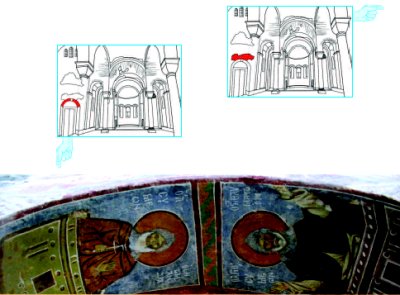
19- Aziz Baküs ve Aziz Sergios
Kuzey giriş kapısı üstündeki iç kemerde, dört aziz freskinin hemen üstünde Aziz Baküs ve Aziz Sergios freskleri işlenmiştir. Her ikisi de karşılıklı olarak kulemsi iki yapıdan aşağı doğru bakmaktadır ve Aziz Baküs elinde haç tutarken, Aziz Serigos kollarını yana doğru açmıştır. Aziz Baküs'ün pelerini, üzerinde bulunduğu yapının rengi ile uyumlu olarak açık kahverengi, Aziz Sergios'unki ise yine üzerinde bulunduğu yapının rengi ile uyum içinde koyu kahverengi olarak resmedilmiştir.
19- Saint Bacus and Saint Sergios
Underneath an arch on the northern entrance door, above four saint figures, Saint Bacus and Saint Sergios figures have been depicted. Both of them are facing each other from tower shaped buildings and looking down. Saint Bacus holds a cross and Saint Sergios stretches his hand to right and left. Saint Bacus' cloak, in conformity with the colour of building he is standing, is light brown whereas Saint Sergios' cloak also is in conformity with the colour of the building on which he standing and is dark brown.
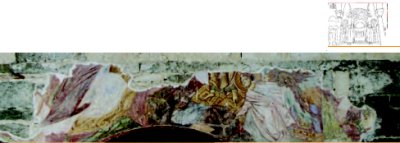
20- İsa'nın Ölüler Ülkesine İnişi (Anastasis)
Güneydoğu pandantifteki sahne, kuzey iç duvarı giriş kapısı üstünde tekrar daha büyük boyutlarda ve detaylı olarak yapılmıştır. En altta muhtemelen zincire vurulmuş olan ölüler ülkesinin bekçisi Hades ve ölüler ülkesinin bronz kapıları görülmektedir. Bugün bu sahnenin sadece alt ayak kısmı görünmektedir ve büyük bölümü tamamen tahrip olmuştur.
20- Christ Descend Into Nehter / Underground World (Anastasias)
The scene on the southern triangular pendentive is probably within much larger dimensions and details repainted on the masonry above northern door. At the bottom of the scene the chained figure probably is Hades, guard of deaths 'country and broken bronze doors of deaths' country are visible. Most parts of the scene have disappeared and only the bottom side is visible at present.
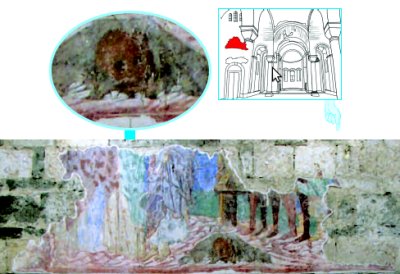
21- İsa'nın Çarmıha Gerilmesi / The Crucifixion (Stavrosis)
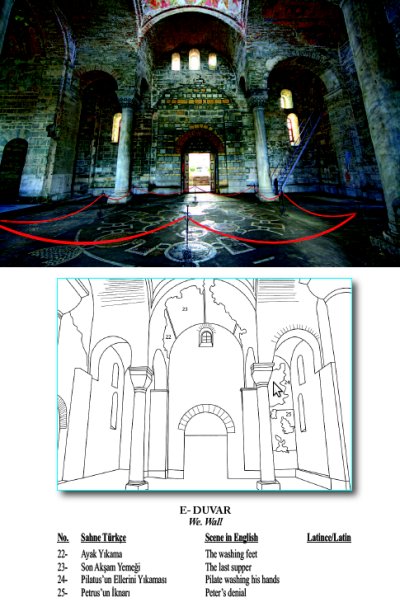
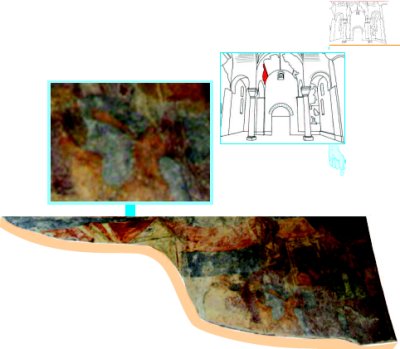
22- Ayak Yıkama
Son akşam yemeği esnasında İsa yemekten kalkar, üstünlüğünü bir yana koyarak bir havlu alır ve beline dolar, bir leğene su doldurarak sıra ile havarilerinin ayaklarını yıkar ve havlu ile kurular. Ayak yıkama sahnelerinde havariler sıra halinde ve ayaklarının İsa tarafından yıkanmasını reddeder durumda gösterilir. En öndeki havari Petrus'tur.
22- Washing The Feet
The feet washing scene generally is depicted next to or under the last supper. The subject of this scene is washing of apostles' feet and blessing of them by Christ. The washing of feet scene has partly disappeared and mostly is not understandable. The event is told by John's Gospel only. At the last supper Christ gets up from the meal, takes off his outer clothing and wraps a towel around his waist. After that, he pours water into a basin and begins to wash his apostles' feet and dries them with the towel. In feet washing scenes apostles are pictured in a range and refusing Christ washing their feet. The foremost apostle is Peter.
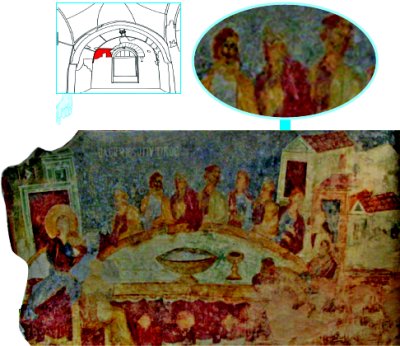
23- Son Akşam Yemeği
Son akşam yemeği, İsa ve havarilerinin gizli bir yerde son kez buluşmalarını anlatır. İsa ve havarileri Fısıh yemeği için bir araya gelirler ve İsa bu yemekte havarilerine içlerinden birinin kendisini ele vereceğini söyler.
23- The Last Supper (Cenaculum)
Last supper scenes show Christ and his apostles last meeting in a secret place. Christ and his apostles come together for Passover and Christ tells one of them will betray him.
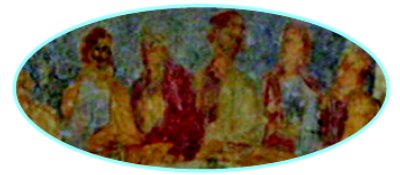
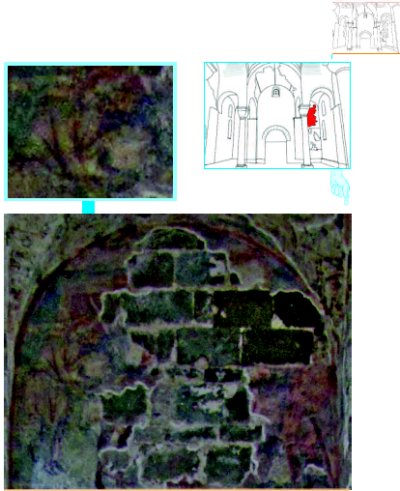
24- Pilatus Ellerini Yıkarken
İsa tutuklanıp yargılandıktan sonra vali Pilatus her Fısıh bayramında halkın istediği bir tutukluyu salıverme geleneğine uyarak halka İsa'nın mı yoksa suçlu Barabas'ın mı salıverilmesini istediklerini sorar, halk da Yahudi kahinlerin kışkırtması ile İsa'nın cezalandırılarak çarmıha gerilmesini, Barabas'ın ise salıverilmesini ister. Halkın bu isteği üzerine, kentte kargaşa çıkacağını gören Pilatus halka; "Bu adamın kanından ben sorumlu değilim bu işe siz bakın" der ve sorumsuzluğunu göstermek için ellerini suyla yıkar.
24- Pilate Washing His Hands
After Christ was arrested and judged, governor Pilate following the custom at the Feast to release a prisoner chosen by the crowd after people gathered asks them; which one do they want him to release to them, Barabas or Christ. With the chief priests' and the elders' persuasion the crowd ask Christ to be crucified and Barabas to be released. Upon this wish of the crowd Pilate noticing that uproar was starting takes water and washes his hands in front of the crowd saying he was innocent of Christ's blood, it was the crowd's responsibility.
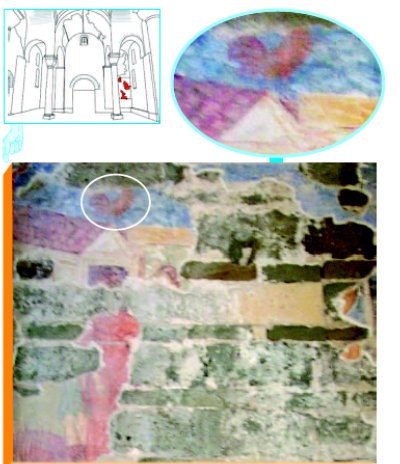
25- Petrus'un İnkarı
Son yemekten sonra İsa havarilerine o gece hepsinin onu inkar edeceğini söyler. Petrus'un herkes inkar etse kendisinin inkar etmeyeceğini söylemesi üzerine İsa, o gece Petrus'un horoz ötmeden önce kendisini üç kez inkar edeceğini söyler. İsa tutuklandıktan sonra İsa'yı takip ederek, Başkahin Kayafa'nın evinin bahçesinde durmakta olan Petrus'a hizmetçi kızlar iki kere, orada toplanmış olanlar da bir kere İsa'nın havarisi olup olmadığını sorar, ancak Petrus İsa ile ilgisi olmadığını söyler. Üçüncü inkarın sonunda horoz üç kez öter.
25- Peter's Denial
After the last supper Christ had told the apostles that at that night all of them will deny him. When Peter had responded that if all fell away, he never would Christ says to Peter that, that night before the rooster crows, he would disown him three times. After the arrest of Christ Peter follows him. While Peter was standing in high priest Caiaphas's house's courtyard, servant girls twice and the people gathered around once ask Peter whether was he was Christ's disciple or not, but Peter denies all. After his third denial the rooster crows. Though the scene is not clear, the rooster over the roof of the house symbolizes this event. Other people in the courtyard and Peter's figure have disappeared due to fallen plaster.
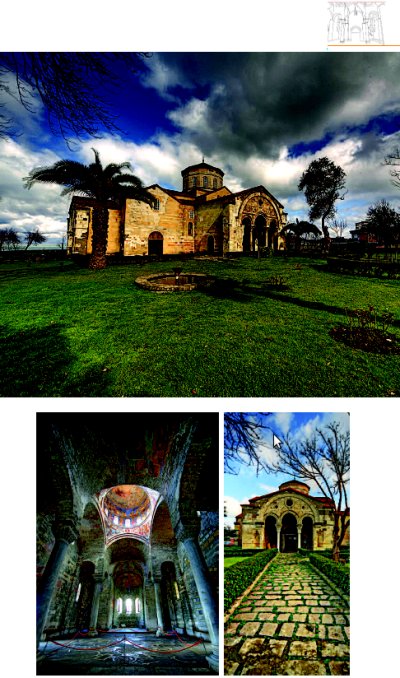
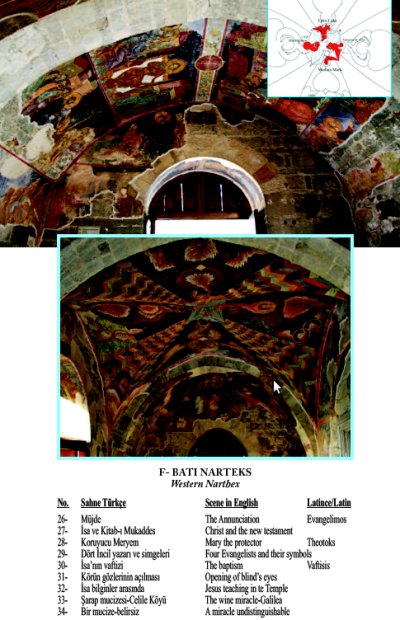
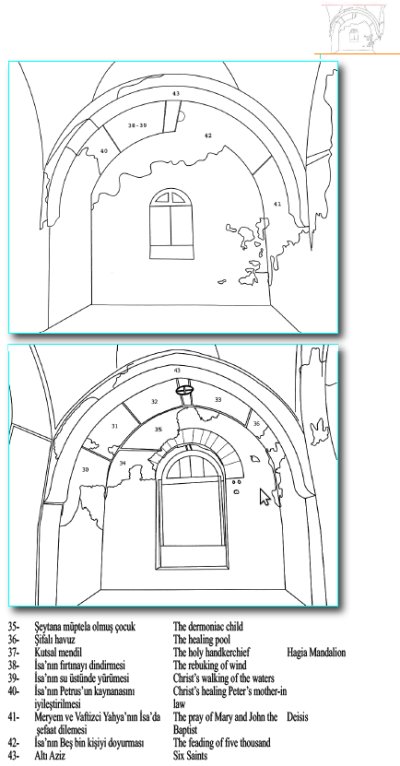
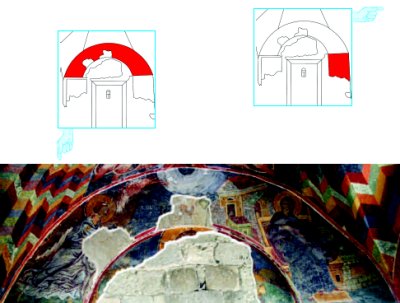
26- Meryem'e Müjde (Evangelimos)
Kuzeni Elizabet'in hamileliğinin altıncı ayında, melek Cebrail Celile'nin Nasıra kentinde, Davut'un soyundan Yusuf adındaki adama nişanlı olan Meryem'in yanına gelir ve Meryem'e tanırının lütfuna ulaştığını, kendisinden korkmamasını ve gebe kalıp bir oğul doğuracağını, adını İsa koyacağını, İsa'nın Davut'un tahtına sahip olacağını müjdeler. Meryem'in meleğe, "Bu nasıl olur? Ben erkeğe varmadım ki" demesi üzerine, Melek ona bunun Tanrının isteği olduğunu ve doğacak olan oğula "Tanrı'nın Oğlu" deneceğini söyleyerek oradan ayrılır.
26- The Annunciation (Evangelimos)
In the sixth month of her cousin Elizabeth's pregnancy, angel Gabriel comes to Nazareth town of Galilee to Mary pledged to be married to a man named Joseph, a descendant of David. Gabriel tells her that she was favoured by God and God is with her, not to afraid, she will be with a child and give birth to a son, give him the name of Christ who will have the throne of his father David. Mary says to the angel that how it is possible, since she was a virgin, and the angel replies that this is the wish of God and the son will be great and will be called the son of God.
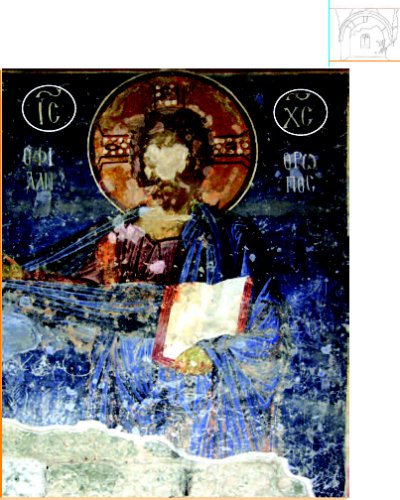
27- İsa ve Kitab-ı Mukaddes
İsa freski oldukça güzel bir şekilde resmedilmiş olmakla birlikte, yüzü tahrip olmuştur. İsa'nın başının her iki yanında "IC XC" harfleri yer alır ki, bu hem "Christos" -Mesih- hem de "Ihtsis" -Balıkanlamlarına gelen bir anagramdır. Freskte İsa elinde Kutsal Kitabı tutmaktadır, arka planla uyumlu olarak koyu mavi renklerin hakim olduğu pelerin giymekte olan İsa'nın sağ eli açık şekilde ileri doğru uzanmıştır.
27- Christ And The New Testament
Though the figure of Christ was extremely well pictured, his face has disappeared. At both sides of Christ's head there are four letters "IC XC", those four letters make an anagram meaning both Christ; Christos and Ihtsis; Fish. In the scene Christ holds a Bible and wears a dark blue Cloak like the background colours and his right hand is stretched towards the door. Below part has disappeared due to the fall of plaster.
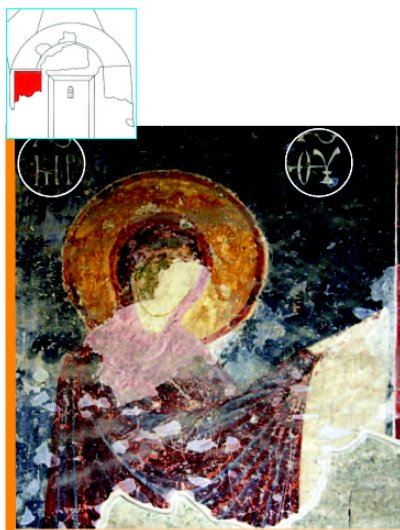
28- Koruyucu Meryem (Theotoks)
Narteksin ana mekana giriş doğu kapısının kuzeyinde, kapının sağ tarafında (bakış acısına göre solda) Meryem freski yer alır. Meryem freski de İsa freski gibi oldukça güzel bir şekilde resmedilmiş olmakla birlikte, onun da yüzü tahrip olmuştur. Meryem'in başının her iki yanında Mitera Theu-Tanrı Anası kelimelerinin ilk ikişer harfleri olan "MP 0Y" harfleri bulunmaktadır. Freskte Meryem sağ elini ileri doğru uzatmıştır, İsa'nın ve arka planın aksine koyu kahve renklerin hakim olduğu pelerin giymektedir.
28- Mary (Theotoks)
To the north of narthex's east door, on the right side of the door (from viewing angle on the left) opposite Christ's figure Mary was pictured. Despite Mary like Christ being extremely well pictured, her face is also invisible. At both sides of Mary's head there are the letters; "MP 0Y" first letters of the term; Mitera Theu meaning Mother of God. In the scene with her son Christ, Mary stretched her right hand towards the door. Contrary to Christ and the background her cloak's colour is dark brown.
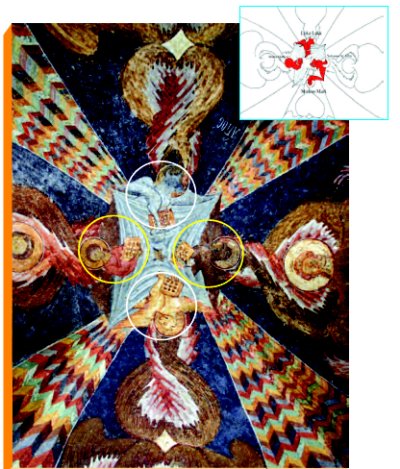
29- Dört İncil Yazarı ve Simgeleri Hayvanlar
Haçtonozdaki figürlerden, İncil yazarlarından Luka'nın simgesi boğadır, bereket ve güç simgesi olarak tarihöncesi çağlardan buyana kullanılmaktadır. Markos'un simgesi aslandır, gücü ve cesareti temsil eder. Yuhanna'nın simgesi kartaldır, insanın ulaşamayacağı yüksekliklere çıkabilen varlığı, bilgiyi temsil eder. Matta'nın simgesi ise melek yada bazı yazarlara göre insandır, tehlikelere karşı korunmayı simgeler.
29- Four Evangelist And Their Symbols
In the centre of narthex's cross vault four evangelists, each evangelist is usually pictured together a symbol with Luke the evangelist, the author of the third Gospel symbolized by a bull, a figure of sacrifice, service and strength. Mark the evangelist, the author of the second Gospel is symbolized by a lion, a figure of courage and monarchy. John the evangelist, the author of the fourth Gospel is symbolized by an eagle, a figure of the sky and believed to be able to look straight into the sun. Matthew the evangelist, the author of the first Gospel is symbolized by a human or an angel, a figure of humanity and reason.
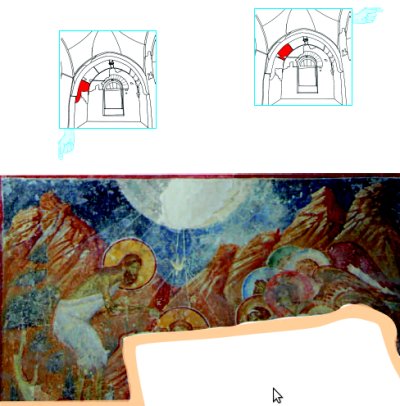
30- İsa'nın Vaftizi (Vaftisis) / The Baptism (Vaftisis)
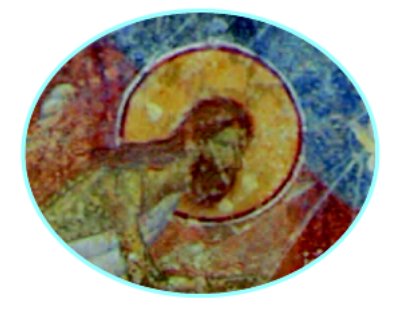
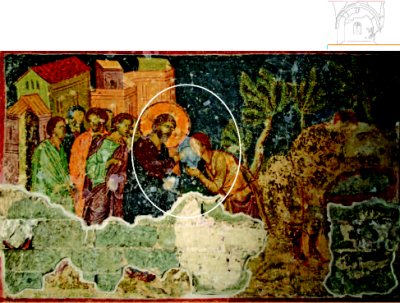
31- Körün Gözlerinin Açılması
Önde İsa, onu takip eden havarileri, İsa'dan yardım isteyen adam, zeytin ağaçları ve havarilerin arkasında kenti simgeleyen evler vardır. İsa ve havarileri farklı renklerde pelerinler giymektedirler. Öykü Yuhanna İncil'inde geçer; İsa havarileri ile birlikte yürürken doğuştan kör bir adama rastlarlar. Havariler İsa'ya adamın kör doğmasının nedenini sorunca, İsa adamın bir mucizenin gerçekleşmesi için kör doğduğunu söyler ve sonra yere tükürerek çamur yapar ve çamuru kör adamın gözlerine sürer. Daha sonra adama git Şiloha havuzunda yıkan der, adam yıkandıktan sonra gözleri açılmış olarak geri döner.
31- The Opening of The Eyes of The Man Who Was Born Blind
At the front is Christ, apostles following behind him, the blind man begging for mercy from Christ, olive trees and houses behind the apostles symbolize the city. The story is told in John's Gospel; as Christ and his apostles are going along they see a man blind from birth. When the apostles asked him the reason for the man's blindness, Christ says it happened so that the work of God may be displayed in his life and he spits on the ground, makes some mud with the saliva, and puts it on the man's eyes. He then tells to him to go and wash in the pool of Siloam. After washing the man comes back and can see.
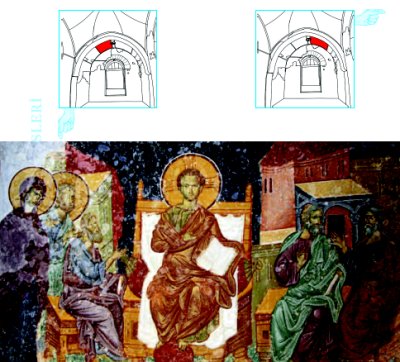
32- İsa Bilginler Arasında
İsa'nın annesi ve babası her yıl Fısıh bayramında Kudüs'e giderlerdi. İsa on iki yaşına gelince, bayram geleneğine uyarak yine Kudüs'e giderler. Bayramdan sonra eve dönerlerken küçük İsa Kudüs'te kalır. Bunu fark etmeyen annesi ve babası, çocuğun yol arkadaşlarıyla birlikte olduğunu sanarak bir günlük yol gittikten sonra, İsa'nın kaybolduğunu fark edince onu aramaya başlarlar, bulamayınca endişe içinde Kudüs'e geri dönerler. Üç gün sonra İsa'yı tapınakta din bilginleri arasında oturmuş, hem onları dinleyip, hem de sorular sorarken bulurlar.
32- Jesus Teaching in The Temple
Every year Christ's parents went to Jerusalem for the feast of the Passover. While Christ was twelve years old, they went to Jerusalem for feasting as was the custom. After the feast was over, while Mary and Joseph were returning home, the boy Jesus stayed behind in Jerusalem, but they were unaware of it, thinking he was with them, and they travelled on for a day. Then they began looking for Jesus asking their relatives and friends, but when they could not find him, they went back to Jerusalem to look for him. After three days they found him in the temple courts, sitting among the teachers, listening to them and asking them questions.
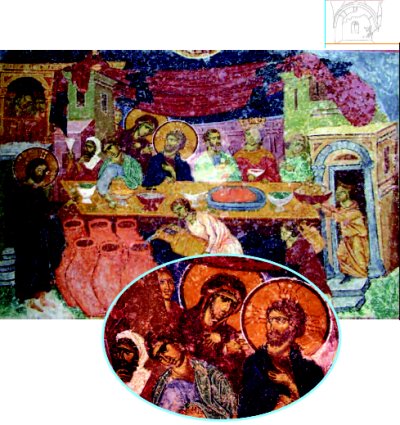
33- İsa'nın İlk Mucizesi: Suyun Şaraba Dönmesi
Celile'nin Kana köyünde bir düğün vardır, İsa, Meryem ve havarileri de düğüne gitmişlerdir. Şarap tükenince annesinin kendisine şarapları kalmadı demesi üzerine, İsa, hizmetçilere Yahudilerin geleneksel temizliği için oraya konmuş, her biri seksenle yüz yirmi litre alan altı taş küpü su ile doldurmalarını söyler. Küpler ağızlarına kadar suyla doldurulduktan sonra, İsa hizmetçilerden küplerdekilerden alarak şölen başkanına götürmelerini ister, şaraba dönüşmüş suyu tadan şölen başkanı, düğün sahiplerine şarabın çok leziz olduğunu bildirir.
33- First Miracle of Christ: Turning Water Into Wine
There was a wedding taking place at Cana in Galilee. Christ, his apostles and Mary also had been invited to the wedding. When the wine was gone, his mother tells Christ that they do not have any more wine but nearby there were six stone water jars each holding from twenty to thirty gallons of water. Christ says to the servants to fill the jars with water. After the jars were filled to the brim, he tells them to draw some out and take it to the master of ceremonies and when the master tasted the water that had been turned into wine he says to the bridegroom that the wine is the best.
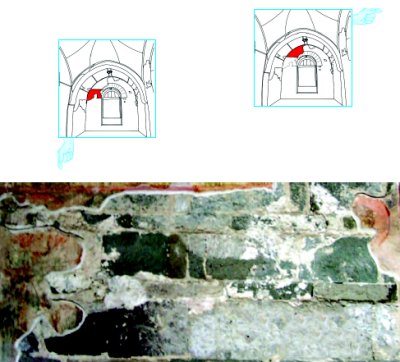
34- Bir Mucize / A Miracle
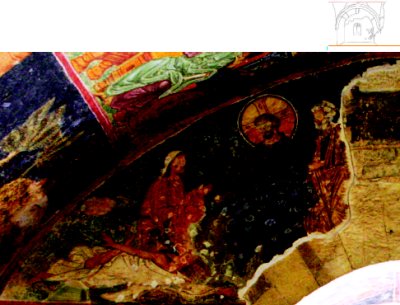
35- Şeytana Müptela Olmuş Çocuğun İyileştirilmesi
Günümüze kalan kısımdaki sahnede şeytana müptela olmuş olan çocuk yerde yatmakta iken annesi İsa'dan yardım istemektedir. İsa'nın hemen arkasındaki kişi çocuğun babası olmalıdır. Öykü Markos İncil'inde geçmektedir; İsa ve havarileri bir kentten geçmektedir, halktan biri İsa'dan dilsiz bir ruha tutsak oğluna yardım etmesini çünkü ruhun çocuğu yere çarptığını, çocuğun ağzından köpükler çıktığını ve kaskatı kesildiğini söyler. İsa ruhu çocuktan kovar ve çocuk sağlığına kavuşur.
35- The Driving Out The Evil Spirit
In the portion appearing today the child possessed by the (evil) spirit lies on the ground with his mother asking Christ for mercy. The figure behind Christ could be father of the child. The story is told in Mark's Gospel. Christ and his apostles were going through a city. One of the people from the crowd gathered around Christ and asks him to help his son, who was possessed by a (evil) spirit that has robbed him of speech. Whenever the evil seizes the boy, it throws him to the ground, the boy foams at the mouth, gnashes his teeth and becomes rigid. He had asked Christ's apostles to drive out the spirit but they could not do it. Christ drives out the spirit and the boy gets healthy.
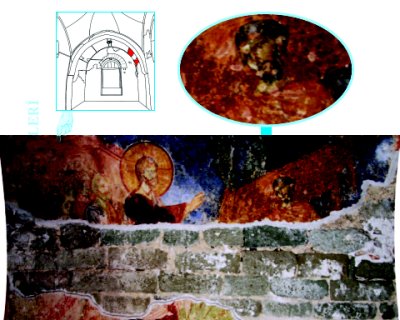
36- Şifalı Havuz
Yahudilerin bir bayramı için Kudüs'e giden İsa, Kudüs'te Koyun Kapısı yanında İbranicede Beytesta denen beş eyvanlı bir havuzun yanından geçmektedir. Orada otuz sekiz yıldır kötürüm olarak yatmakta olan bir adam vardır. İsa adama iyi olmak ister misin diye sorunca adam; "Efendim, su çalkandığı zaman havuza indirecek kimsem yok, -inanışa göre bir melek arasıra iner havuzun suyunu çalkalardı, su çalkalanınca havuza ilk giren kişi hastalıklarından kurtulurdu- tam gireceğim an benden başkası giriyor" der. İsa adama, "Kalk, döşeğini topla ve yürü" der. Adam o anda iyileşir, döşeğini toplayıp yürümeye başlar.
36- The Healing Pool
Christ and his apostles had gone up to Jerusalem for a feast of the Jews. In Jerusalem, near the Sheep Gate there was a pool, which in Aramic is called Bethesda and which is surrounded by five covered colonnades. A man was there who had been an invalid for thirtyeight years. When Christ asked him if he wants to get well, the invalid replies that; Sir I have no one to help me into the pool when the water is stirred. From time to time an angel was coming down and stirring up the waters. The first one into the pool after each such disturbance would be cured of whatever disease he had. While I am trying to get in, someone else goes down ahead of me, the man says. Christ says to him to get up, pick up his mat and walk. The man is cured at once, picks up his mat and walks.
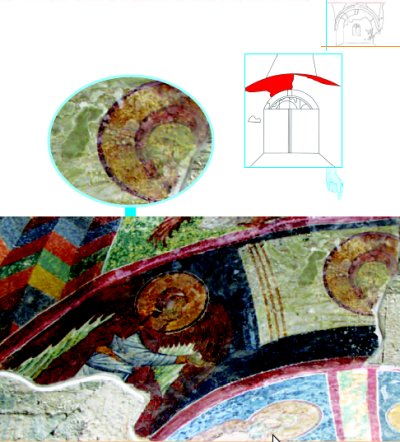
37- Kutsal Mendil (Hagia Mandalion)
Urfa prensi Abgaros hastalanır ve iyileşmek için İsa'dan yardım ister. İsa da Urfa'ya gitmek yerine bir mendili yüzüne bastırır ve yüzünün şeklini almış olan bu mendili prensin elçisi Ananias'a vererek gönderir. Mendili alan Abgaros sağlığına kavuşur ve mendili bir tahtaya gerdirerek kentin giriş kapısındaki bir nişin içine koydurur. Bizans sanatı ve sonrasında sürekli karşılaşılan, gür saçlı, sakallı, orta yaşlı İsa bu simayı kutsal mendil efsanesi ile birlikte almıştır. Freskte kenarları işlemeli mendilde İsa'nın yüzü görülmektedir.
37- The Holy Handkerchief (Hagia Mandalion)
According to the best known Orthodox story Abgar the King of Urfa got ill and asks Christ to be healed. Upon this wish, Christ wipes his face with a handkerchief and sends the handkerchief that has his face imprinted on to King Abgar via his couriers. After handling the handkerchief, Abgar is healed at once. In the scene an embroidered handkerchief is pictured.
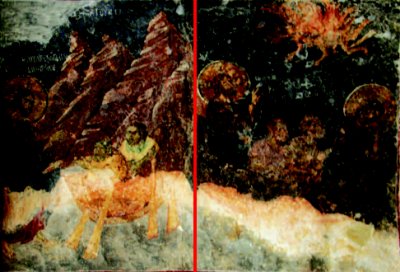
38-39- İsa'nın Su Üstünde Yürümesi ve Fırtınayı Dindirmesi
Beşbin kişiyi doyurma mucizesinden sonra İsa havarilerini kayıkla gölün karşı yakasına gönderir. Havariler fırtınaya tutulurlar, İsa sabaha karşı gölün üstünde yürüyerek havarilerinin yanına gider. İsa'yı gölün üstünde yürürken gören havariler hayalet sanarak korkuya kapılır. İsa kayığa binince fırtına diner. Aynı sahnenin ikinci kısmında ise; İsa Celile Gölü kıyısında toplanan hastaları iyileştirir. Daha sonra havarileri ile birlikte gölün karşı yakasına geçerken kayıkta uyur, bu esnada gölde fırtına çıkar, fırtına o kadar şiddetlidir ki kayık batmak üzeredir. Havarileri korkuyla İsa'yı uyandırırlar, İsa'nın rüzgarı ve gölü azarlaması üzerine rüzgar diner göl sütliman olur.
38-39- The Walking on The Water And Calming The Storm
After feeding five thousand people, Christ makes his apostles get into the boat and go on ahead of him to the other side of the lake. The boat is buffeted by the waves because the wind was against it. During the fourth watch of the night Christ goes out to them, walking on the lake. When the apostles saw him walking on the lake, they were terrified thinking it was a ghost. After Christ climbed into the boat, the wind dies down. In the second part of the same scene, Christ heals people who are ill gathered by the Galilee lake and later while going over to the other side of the lake, a furious squall comes up, and the waves break over the boat, so that it was nearly swamped. Christ was in the stern, sleeping on a cushion, the apostles were frightened and woke Christ, he gets up, calms the wind, says to the waves to be quiet and the wind dies down and was completely calm.
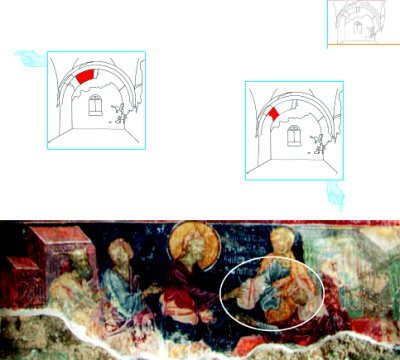
40- İsa'nın Petrus'un Kaynanasını İyileştirmesi
Sadece üst kısım sağlamdır ve sahne kısmen anlamlandırılabilir durumdadır. Sahnede sadece İsa'nın başında hale vardır ve İsa eli ile hasta kadına dokunmaktadır. Petrus'un hasta kaynanası sahnenin kuzey tarafında yatmaktadır. Öykü birbirleri ile büyük oranda benzerlik gösteren sinoptik İncil'lerde geçmektedir; İsa Kefernahum'da Petrus'un evine gelir ve Petrus'un kaynanasının ateşler içinde yattığını görür. İsa hasta kadının eline dokunarak onu iyileştirir. Hasta kadın kalkarak İsa'ya hizmet etmeye başlar.
40- The Healing of Peter's Mothor-İn-Law Was Born Blind
Christ's healing of apostle Peter's mother-in-law has been pictured. The lower portion has disappeared due to the fall of plaster underneath. Only the upper part appears today and the scene is only partly understandable. In the scene, a halo is only depicted on the head of Christ and he touches the ill women with his hand. The ill mother-in-law of Peter lies down in the north of the scene. The story is told in the synoptic Gospels. In Capernaum Christ comes to Peter's house and sees that Peter's mother-in-law was lying in bed with a fever. Christ touches her hand and heals her. The ill woman gets up and begins to wait on Christ.
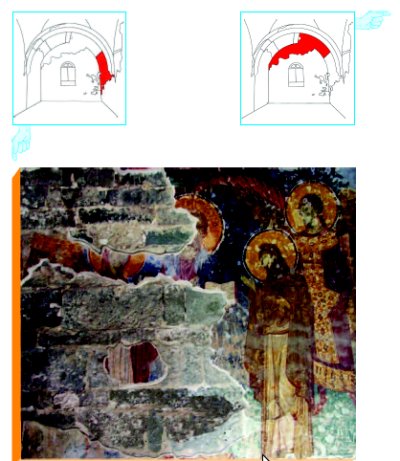
41- Meryem ve Vaftizci Yahya'nın İsa'dan Şefaat Dilemesi (Deisis)
Deisis sahnesi genellikle apsise çizilmekle birlikte farklı yerlere de çizilebilir. Ayasofya'da, Batı Nartkes kuzey taraftaki doğu duvarının alt kısmında yer alır. Sahne büyük oranda tahrip olmuştur. Başında hale bulunan İsa ortadadır ve çok az bir kısmı görülebilir durumdadır. İsa'nın sağındaki Meryem figürü başının çok az bir kısmı hariç hemen hemen tamamen tahrip olmuş iken, solundaki Yahya ve arkasındaki melek görülebilir durumdadır.
41- The Pray of Mary And John The Baptist (Deisis)
The scene of deisis generally is depicted on the central apse but may also be pictured in different places. In the Hagia Sophia the scene has been pictured on the lower part of the western narthex north side's eastern masonry. The scene has mostly disappeared. Christ is wearing a halo over his head in the middle and is partly visible. Whereas to the right the figure of Mary has almost disappeared except part of her head, John the Baptist and behind him angels are visible and seem to be in good order.
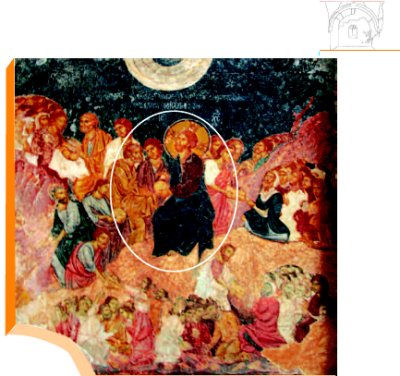
42- Beşbin Kişinin Doyurulması
Vaftizci Yahya'nın bölge kralı Hirodes tarafından başı kesilerek öldürüldüğünü öğrenen İsa tek başına bir kayıkla Celile gölü kenarındaki Kefernahum'da tenha bir yere gider ve bu olayı duyan halk onu izler. İsa kayıktan inince büyük bir kalabalıkla karşılaşır, hastaların hastalıklarını iyileştirir. Akşam olunca havarileri sadece beş ekmek ve iki balıkları olduğunu bu kadar insanı, yaklaşık beş bin kişiyi doyurmalarının mümkün olmadığını söyler. İsa da onlara halkın evlerine gönderilmesine gerek olmadığını söyler ve halkı yanına çağırarak beş ekmeği iki balığı bölüştürerek havarilerine verir ve havariler de ekmek ve balıkları halka dağıtırlar. Herkes doyar iki sepet ekmek artar.
42- The Feeding of The Five Thousand
John the Baptist had been beheaded by the order of Hirodes Antipas and when Christ heard what had happened he withdraws by boat privately to a solitary place and hearing of this the crowds follow him on foot from the towns. When Christ landed and saw a large crowd, he had compassion on them and heals their sick. As evening approaches, apostles come to Christ saying he should send the crowds away because they needed to be fed and the apostles had only five loaves of bread and two fish to eat. Christ tells them the crowds do not need to go away and he directs everyone to sit down on the grass, he takes five loaves and breaks them and two fishes and gives them to the apostles who give them to the people. All the people there eat the food and are satisfied, and there are twelve basketfuls of broken pieces that are left over.
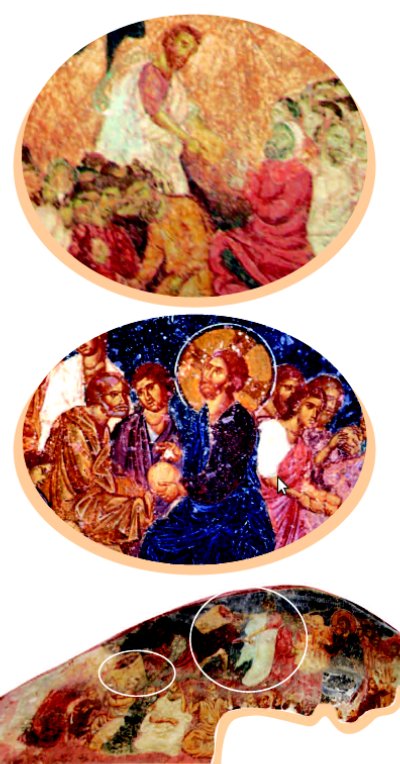
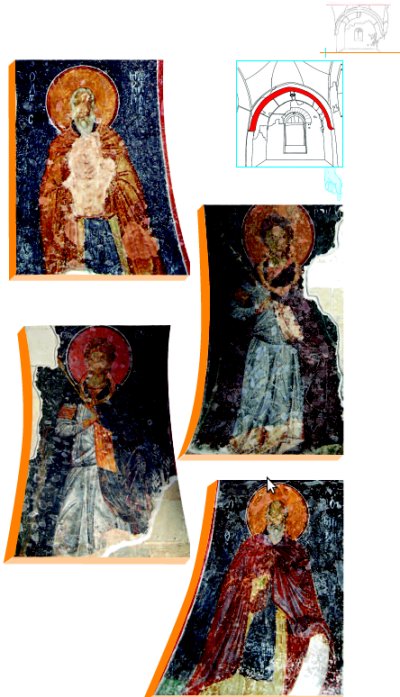
43- Kuzey ve Güney Kemerlerde Altı Aziz / Six Saints on Each of The South and North Arches
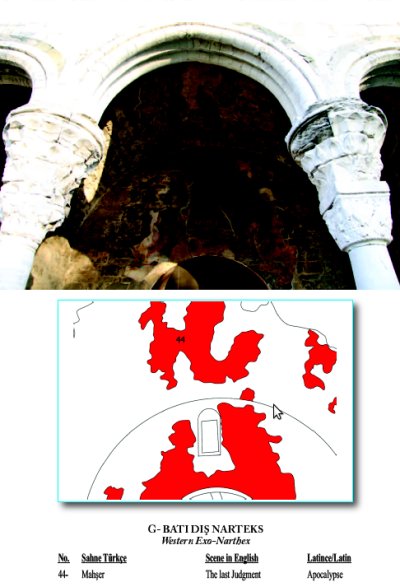
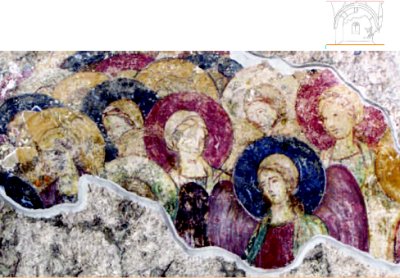
44- Mahşer
Batı Narteksinden sonra gelen Dış-Narteksin doğu duvarında ve beşik tonozunda komple son yargı günü-mahşer sahnesi işlenmiştir. Sahne büyük oranda tahrip olmuştur ve kısmen görülebilir durumdadır. Sahnedeki insan kalabalığı dikkat çekicidir.
44- The Last Judgment (Apocalypse)
On the eastern wall and barrel vault of the western exo-narthex coming after the endo-narthex the entire scene of the apocalypse has been depicted. The scene has mostly disappeared and only partly visible. The people in the crowd scene attract attention.
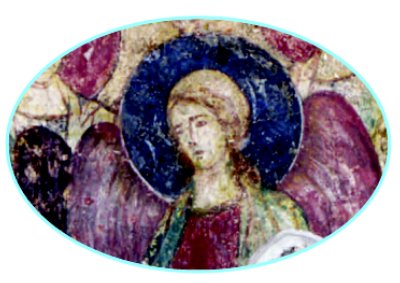
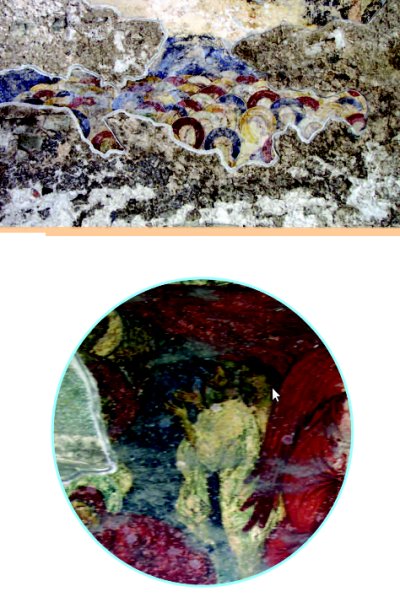
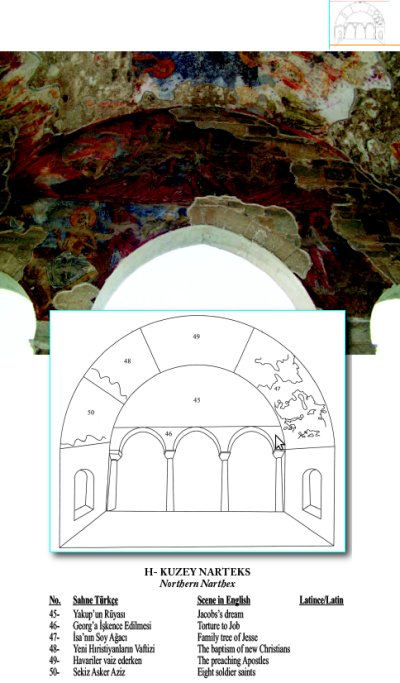
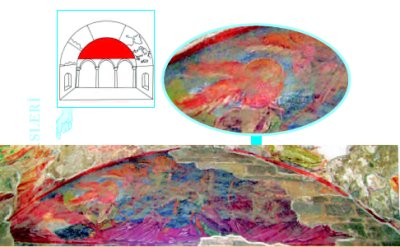
45- Yakup'un Rüyası
İbrahim'in iki oğlundan İshak'ın -diğeri İsmail- oğlu olan Yakup, kardeşi Esav ile arasında çıkan anlaşmazlık nedeniyle Beer-Şeva'dan ayrılarak Harran'a dayısının yanına doğru yola çıkar. Hava karardığı için Beytel'de başının altına bir taş koyarak uykuya dalar. Rüyasında gök ile yeryüzü arasına bir merdiven dikildiğini, başının göklere eriştiğini görür. Melekler merdivenden çıkıp inmektedirler, Tanrı, Yakup'a üzerinde bulunduğu toprakları ona ve soyuna vereceğini ve onu koruyacağını vaat eder. Eski Ahit'e göre; İsrail oğullarının soyu Yakup peygamberden türemiştir ve Yakup peygamber Yabbuk ırmağının kenarında tanrı ile güreştiği için, tanrı ile güreşip onu yenen anlamında İsrail adını almıştır.
45- Jacob's Dream
One of Abraham's sons Isaac -the other is Ishmael- due to a disagreement with his elder brother Esau leaves Beersheba and sets out for Harran to his mother's brother. When he reached Bethel, he stops because the sun had set. He takes one of the stones there, puts it under his head and lies down to sleep. He has a dream in which he sees a stairway resting on the earth, with its top reaching to heaven and angels were ascending and descending it. God says to him that He will give him and his descendants the land on which he is lying. According to the Old Testament Jacob is the father of Israelites and because Jacob wrestled with God on the bank of the Jabbok ford his people are called Israelites meaning 'wrestled with God and overpowered Him'.
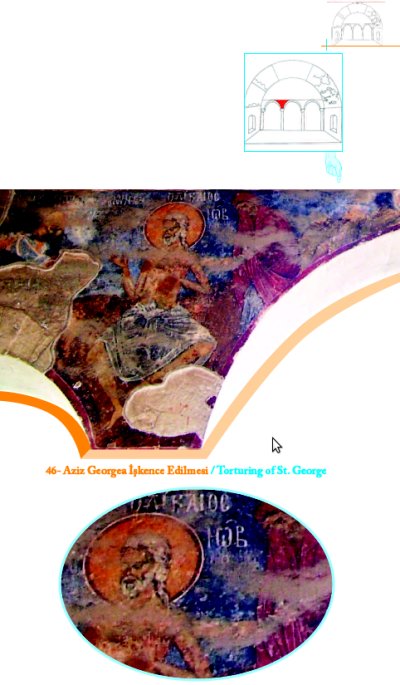
46- Aziz Georgea İşkence Edilmesi / Torturing of St. George
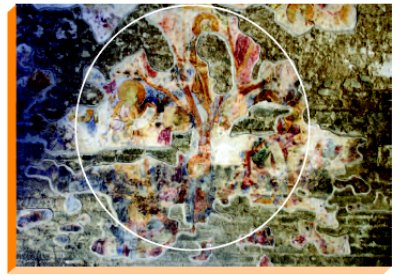
47- İsa'nın Soyağacı
Matta İncil'i İsa'nın soy ağacı ile başlar ve İsa'nın soy ağacını babası Yusuf'tan başlatıp, Yahudilerin atası İbrahim Peygambere kadar indirirken, Luka İncil'i İsa'nın soy ağacını 3. bölümünde vererek, Matta gibi babası Yusuf'tan başlatır ve ilk insan Adem'e kadar götürür. Eski Yahudi inancına göre Mesih'in Davut Peygamber soyundan gelmesi gerekmektedir. Her iki İncil'in verdiği soy ağacı Davut'tan İbrahim'e kadar paralellik gösterir ve bu noktadan sonra İki İncil arasında soy ağacı konusunda uyumsuzluk ortaya çıkar.
Her iki İncil de İsa'nın soy ağacını verirken, İsa'nın soyunu babası Yusuf'tan başlatır, Davut'un soyundan olan İsa'nın annesi Meryem değil, babası marangoz Yusuf'tur. Oysa İsa babasız doğmuştur, Yusuf ile arasında hiçbir kan bağı yoktur ve bu nedenle soy zincirinin annesinin kocası Yusuf üzerinden takibi imkansızdır. Her iki İncil yazarı İsa'nın soyunu Mesih beklenen Davut Peygambere dayandırmaya çalışırken muhtemelen bu çelişkiyi gözden kaçırmışlardır.
47- Family Tree of Jesse
Matthew's Gospel begins with Christ's genealogy and starts his family tree from his father Joseph and takes it back to the Jews' ancestor Abraham, whereas, Luke's Gospel gives Christ's genealogy in its 3rd Chapter and like Matthew starts from his father Joseph but takes it back to the first man Adam. In accordance with old Jewish beliefs, Christ should have come from David's linage. Both family trees given by the two Gospels are parallel from David to Abraham but after this point differences occur between the two.
Moreover, whilst they are giving Christ's genealogy both Gospels start Christ's linage from his father Joseph, Mary does not from David's ancestry. It is Christ's father carpenter Joseph who comes from David's ancestry, whereas, Christ was born without a father and he does not have any blood tie with Joseph. Therefore due to this reason following Christ's lineage from Joseph is impossible. The two evangelists while trying to take Christ's linage to David from which a saviour Christ had been expected, probably missed this contradiction.
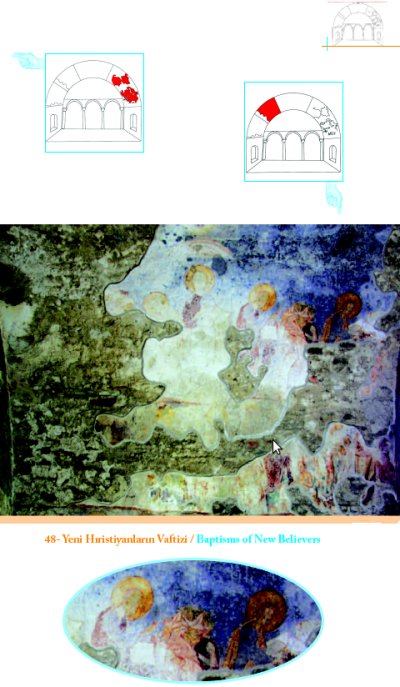
48- Yeni Hıristiyanların Vaftizi / Baptisms of New Believers
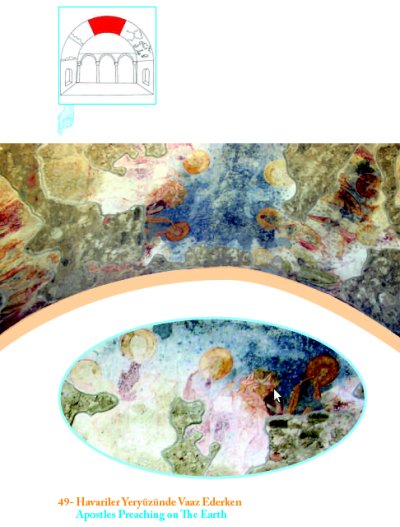
49- Havariler Yeryüzünde Vaaz Ederken / Apostles Preaching on The Earth
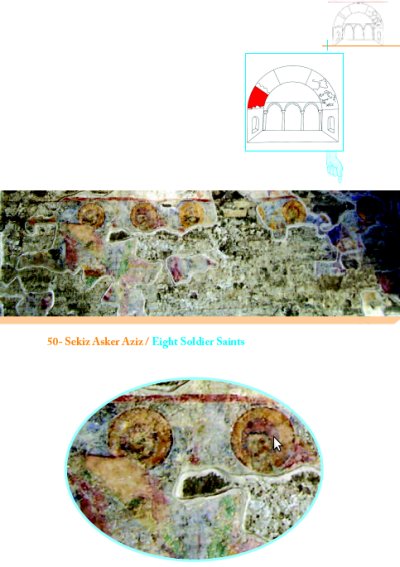
50- Sekiz Asker Aziz / Eight Soldier Saints
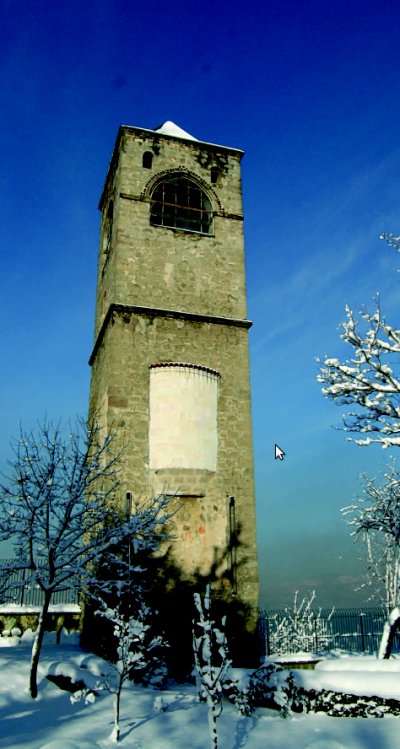
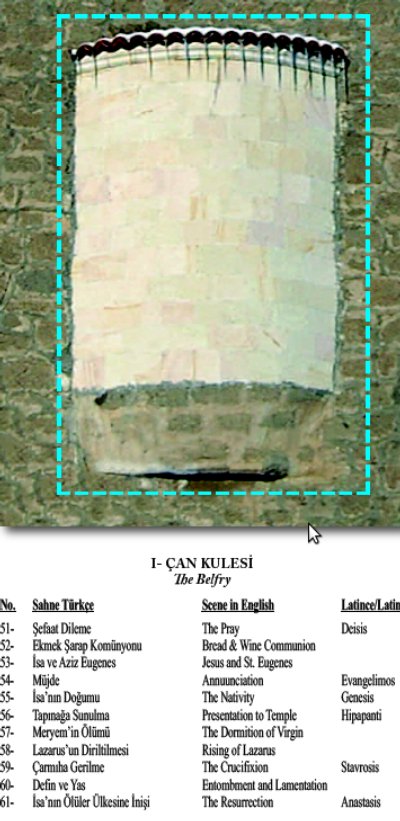
Çan Kulesi'nin Freskleri
Çan Kulesinin ikinci katında yer alan şapelin doğu tarafında dışarı doğru bombeli bir şekilde inşa edilen apsisin dış yüzeyinde kraliyet elbiseleri içinde üç kişinin, 1417-1429 yılları arasında hüküm süren IV. Aleksious, ikinci oğlu Alexander ve gelininin freskleri olduğu söylenmektedir. Varsa bile bugün bu freskler tamamen yok olmuştur. Şapelin dört yanındaki duvarlar ve doğuya doğru yarım daire şeklinde olan küçük apsisi fresklerle süslenmiştir. Talbot Rice fresklerin yapılış tarihini fetihten 18 yıl önce, 1443 olarak vermektedir. Şapeldeki freskler korunmuş olmakla birlikte özellikle yüz bölümleri büyük oranda tahrip edilmiştir. Doğu duvarındaki apsiste vaktiyle azizlerin, peygamberlerin resimleri vardı fakat bunlar bugün tamamen yok olmuştur. Apsis, üç köşeli kenarlar ve duvarlar farklı sahnelerle, burada yaşamış olan rahiplerin resimleri ile kaplanmıştır fakat bugün bunların çok azı anlaşılabilir durumdadır.
Doğu duvarındaki apsiste Trabzon'daki dini yapılarda çokça kullanılan Deisis sahnesi işlenmiştir. Deisis sahnesinin altındaki sahnede her iki yanda Ekmek Şarap Komünyonu resmedilmiştir. Kuzey tarafta ekmek verilirken güney tarafta şarap verilmektedir. Duvarlardaki freskler iki sıraya ayrılmıştır ve üst sırası İncil'den öykülerden oluşurken alt sıra aziz ve keşişlerin resimlerinden oluşmaktadır. Bu sahnelerin büyük bölümü tahrip olmuştur ve anlamlandırılamaz durumdadır.
Batı duvarındaki sahne Başkalaşım sahnesinin bir kısmıdır. Sahnenin diğer kısmı muhtemelen tahrip olmuştur. Sahnede İsa ve başkalaşıma tanıklık eden İlyas peygamber görülmektedir. Doğu Tarafında Meryem'e Müjde sahnesi yer almaktadır. Sahne çok iyi durumda olmamakla birlikte anlaşılabilir durumdadır. Müjde sahnesinden hemen sonra ortada İsa'nın Doğumu sahnesi yer alır. Bu fresk de çok iyi durumda olmamakla birlikte arka plandaki öküz ve at kolaylıkla görülebilir durumdadır. Doğum sahnesinin batısında İsa'nın tapınağa sunulması ve Aziz Simeon tarafından kutsanması sahneleri yer alır. Sahnede Aziz Simeon arkasında Azize Anne, Meryem ve Yusuf bulunmaktadır. Aziz Simeon bebek İsa'yı tutmaktadır.
Batı duvarında, Meryem'in Ölümü sahnesi işlenmiştir. Sahne çok iyi durumda değildir fakat ölüm döşeğinde yatmakta olan Meryem açıkça görülebilir durumdadır. Şapelde Lazarus'un Diriltilmesi ve Kudüse Giriş Sahneleri de vardı ama maalesef tahrip olmuşlardır.
Kuzey duvarında, İsa'nın çarmıha geriliş sahnesi resmedilmiştir. Çarmıh sahnesi oldukça iyi korunmuştur. Üç Meryem, görevli askerler ve Yuhanna sahneyi tamamlamaktadır. Çarmıh sahnesinden hemen sonra İsa'nın defini ve yas sahnesi yer alır. Defin sahnesi çok net olmamakla birlikte anlaşılabilir durumdadır. Şapel içinde anlamlandırılabilecek son sahne Yeniden Diriliş (Anastasis) sahnesidir.
Frescoes of Belfry
Fre On the outside of the bell tower, on the second storey to the east traces of plaster and paint still remain but nothing can be distinguished-there were three persons wearing crowns and imperial robes. It is said that they were Alexious IV (1417-1429), his second son Alexander and his daughter-in-law. There is a small chapel on the second storey to the east. This Chapel's sides, vaults and semicircular small apse to the east have been decorated with frescoes. D.T. Rice dates the frescoes to 1443, 18 years before the conquest. Though the frescoes in the chapel are fairly well preserved, their faces have mostly disappeared. On the walls of the eastern apse saints and prophets' figures had been depicted but they all have disappeared. Triangular spaces in the corners of the apse, between the side walls were painted by monks who lived there although very little of them are now distinguishable.
On the apse to the east the most popular apse scene at Trabzon Deisis is depicted. The scene below Deisis on both sides is the Communion of the Apostles, to the north the Giving of Bread, to the south the Giving of Wine are depicted. The scenes on the wall are divided into two parts, the upper register showed the Gospel cycle whereas the lower was filled with figures of monks and saints. These scenes have mostly disappeared with nothing able to be distinguished.
The scene on the western wall is part of the Metamorfosis. The other part of the scene was probably destroyed. In the scene Christ and Elijah witnessing the transfiguration are visible. To the east, the Annunciation is depicted. Though the scene is not in good order, it is understandable. After the annunciation in the middle is the Nativity. This scene is also not well preserved but the oxen and horse in the background can be easily seen. (Figure 02) To the west of the Nativity, Presentation to Temple and St. Simeon are visible. In the scene, there are figures of St. Simeon, behind him St. Anne, Mary and Joseph. St. Simeon holds the baby Christ.
On the western wall, the Dormition of the Mary is pictured. The scene is not well preserved but Mary lying at the centre is visible. In the chapel there was the Rising of Lazarus and Entry into Jerusalem, but unfortunately they are not visible today.
On the north wall the Crucifixion is depicted. The scene is extremely well preserved. Three Marys, charged soldiers and St. John fill the scene. After the Crucifixion there are the scenes of Entombment and Lamentation. Though the entombment is not clear it is understandable. The last scene in the chapel which can be explained is Resurrection (Anastasias).
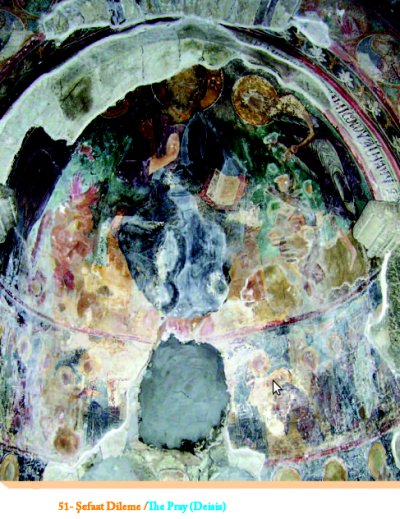
51- Şefaat Dileme / The Pray (Deisis)
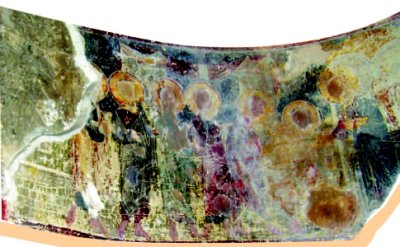
52- Ekmek Şarap Komünyonu
Son Yemek sırasında; İsa eline ekmeği alır ve şükran duasını okur, elindeki ekmeği böler, "alın bu benim bedenimdir" diyerek havarilerine verir, sonra bir kase alır, şükreder ve bunu da öğrencilerine vererek, "alın bu benim kanımdır" der. Böylece çarmıha gerilmeden önce, havarilerini son defa sembolik olarak kutsamış olur.
52- Bread and Wince Communion
Last Supper, the final meal that Jesus Christ shared with his apostles before his arrest and eventual crucifixion. The consecration of bread and a cup within the rite recalls the moment at the Last Supper when Jesus gave his apostles bread, saying, "This is my body", and wine, saying, "This is my blood". Thus Christ sanctifies his apostles before eventual crucifixion.
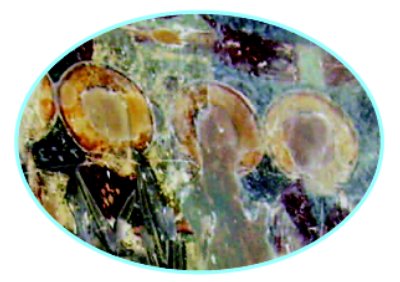
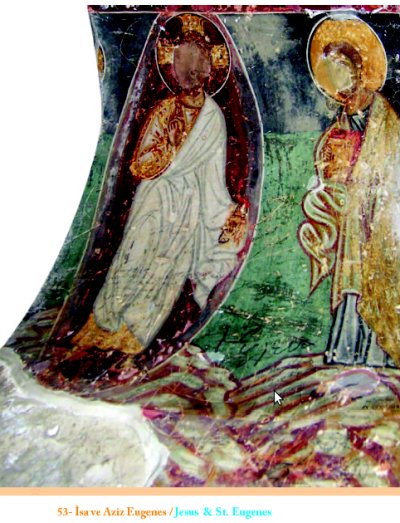
53- İsa ve Aziz Eugenes / Jesus & St. Eugenes
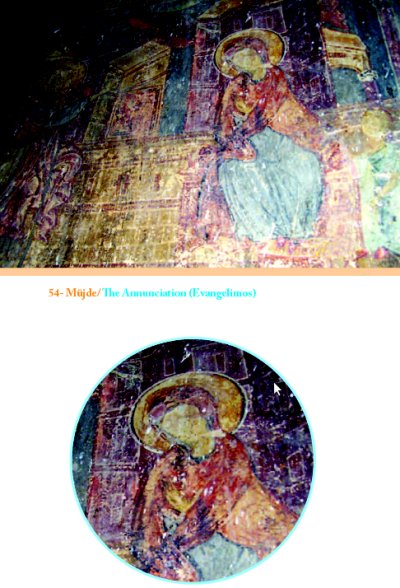
54- Müjde / The Annunciation (Evangelimos)
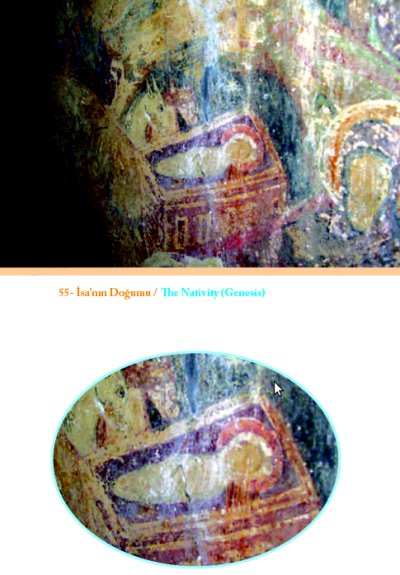
55- İsa'nın Doğumu / The Nativity (Genesis)
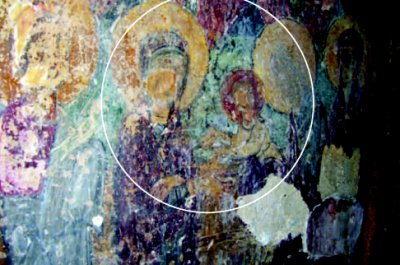
56- Tapınağa Sunulma
İsa sekiz günlük olunca sünnet edilmek ve Tanrı'ya adanmak üzere tapınağa götürülür. Musa peygamber zamanında İsrail Oğulları Mısır'da köle iken, firavun gitmelerine izin vermediği için Tanrı tüm Mısır'daki ilk doğan insan ve hayvanları öldürmüş, sadece İsrail oğullarının ilk doğanlarının yaşamasına izin vermişti. Bundan sonra Tanrı emri olarak ilk doğan erkek çocuk Tanrı'ya adanmış sayılır, sekiz günlük olunca tapınağa adanır, sünnet edilir ve çocuğa kurban sunulurdu. Tapınakta Şimon adında doğru ve dindar bir adam vardır. Şimon tapınağa getirilen İsa'yı büyük bir sevinçle kucağına alır, onu ve annesini kutsar, İsa'nın İsrail'de pek çok kişinin düşüşüne yada yükselişine sebep olacağını söyler.
56- Presentation to Temple (Hipapanti)
On the eight day of birth, Jesus is brought to temple to be circumcised and presented to God. The ritual originates from the time of Moses when the Israelites are under slavery in Egypt; upon pharaoh's rejection of their freedom, except for the Israelites, all firstborn human and animals of Egyptians were killed by the God. After this event, as an order of God, every firstborn male was to be consecrated to God when the baby was eight days old by circumcision and presentation to the God at a temple. In the temple there was a man named Simeon. Simeon with great joy takes Baby Jesus in his arms, blesses him and his mother and states that Jesus is destined to cause the falling and rising may in Israel.
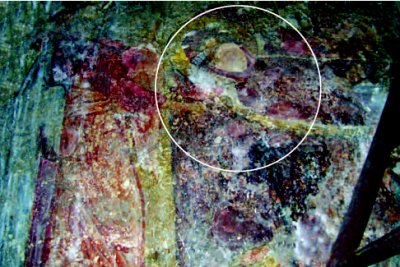
57- Meryem'in Ölümü
İsa'nın çarmıha gerilmesinden sonra annesi oğlunun çok sevdiği havarisi İncil yazarı Yuhanna ile birlikte oturmaya başlar, fakat oğlunun ölümünden sonra, oğlundan ayrı yaşama acısına dayanamayan Meryem Tanrı'dan ruhunu almasını ister. Bir melek Meryem'e görünerek bir palmiye dalı verir ve üç gün içinde öleceğini söyler. Meryem palmiyeyi mezarına dikilmek üzere Yuhanna'ya teslim eder ve bütün havarilerin ölümünde hazır bulunmalarını ister. Meryem'in bu isteği üzerine o esnada kentte bulunmayan Thomas hariç on bir havari ölüm sahnesinde Meryem'in yanında bulunur. İsa gelerek annesinin ruhunu alır.
57- The Dormition of Virgin
After the crucifixion, Mary begins to live with apostle the evangelist Luke whom Jesus loved. After Jesus' death Mary could not bear the sorrow, and asked God to take her soul. An angel comes to her, gives her a palm branch and tells her that she would die in three days. Mary gives the palm branch to John to be planted on her grave after her burial and asks all apostles to be with her while dying. Upon her wish, except Thomas who was not there at that moment, eleven apostles are present in her dying moments. Christ comes and takes her mother.
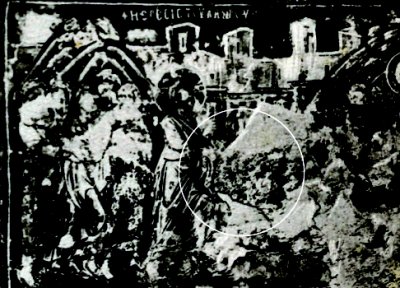
58- Lazarus'un Diriltilmesi
İsa'ya Lazarus'un hastalandığı haberi ulaşır. Haber üzerine İsa Beytanya'ya gelir, Lazarus'un kız kardeşi Meryem İsa'yı karşılayarak ayaklarına kapanır ve orada olsa idi kardeşinin ölmeyeceğin söyler. Bunun üzerine, İsa, havarileri, Lazarus'un kız kardeşleri Meryem, Marta ve onları teselli etmeye gelmiş olan komşuları ile birlikte Lazarus'un konulmuş olduğu mağaranın önüne giderler. İsa'nın isteği ile mağaranın önündeki taş kaldırılır ve İsa "Lazar dışarı çık" der. Lazarus etraftakilerin hayret dolu bakışları arasında sarılmış olduğu kefen sargıları içinde dirilerek mezardan dışarı çıkar.
58- Rising of Lazarus
The word was sent to Christ that Lazarus was sick. When he heard this, Christ comes to Bethany, Lazarus' sister Mary meets Christ and falls at his feet saying to him, if he were there her brother would not die. After this word, Christ, the apostles, Lazarus' sisters, Mary and Martha, and their neighbours who had come to comfort them lead Christ to the tomb where Lazarus had been buried four days ago. By the order of Christ the stone across the entrance is removed and he calls in a loud voice, "Lazarus, come out". Lazarus comes out, his hands and feet wrapped with strips of linen and a cloth around his face.
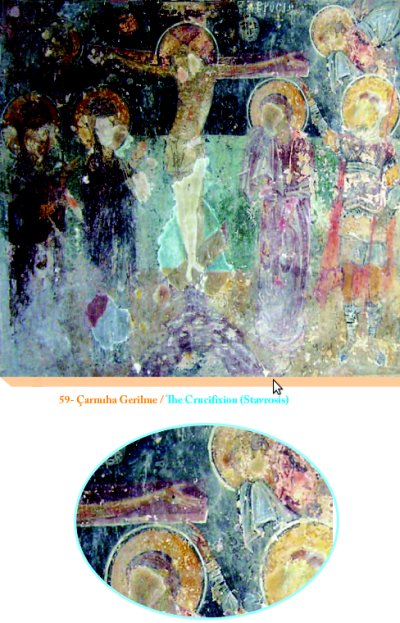
59- Çarmıha Gerilme / The Crucifixion (Stavrosis)
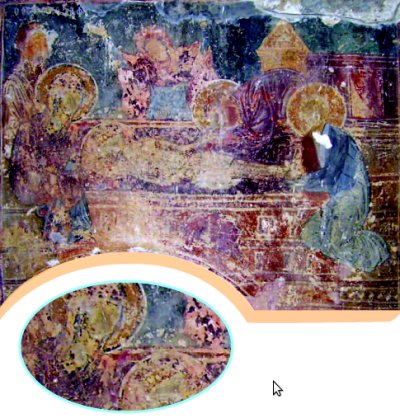
60- Defin ve Yas
Aramatyalı Yusuf ve Nikodim çarmıhtan indirdikten sonra İsa'yı keten bezlere sarar, hoş kokular sürer ve mezar olarak hazırlanmış bir mağara kovuğuna Yahudi geleneklerine uygun olarak defnederek mağaranın önünü büyük bir taş ile kapatırlar.
60- The Lamentation and Entombment
After the descent Joseph of Arimathea and Nicodemus balm the body with myrrh, aloe and put him in strips of linen. In accordance with Jewish burial customs, both put him a new tomb and roll a stone against the entrance of the tomb.
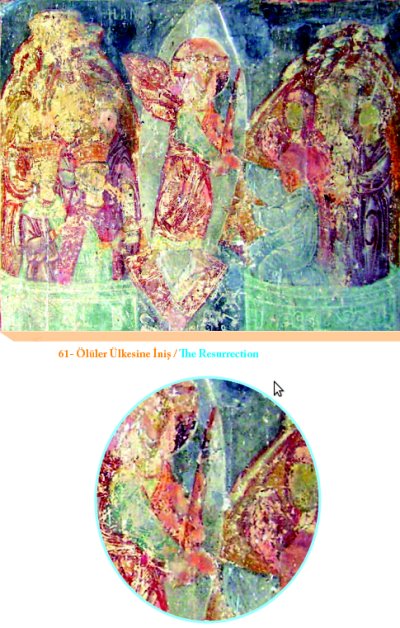
61- Ölüler Ülkesine İniş / The Resurrection
